Special Report
Easiest (and Hardest) States to Find Full-Time Work

Published:
Last Updated:

More than a quarter million jobs were added to the U.S. economy in July, and the official unemployment rate remained unchanged at just under 5%, according to the latest jobs report from the Bureau of Labor Statistics. However, some of these jobs were undesired part-time positions, and the official unemployment rate often gives an incomplete picture of the nation’s labor market.
24/7 Wall St. reviewed the underemployment rate in every state. Nevada is the hardest state in which to find full-time work, with an underemployment rate of 13.1%. South Dakota is arguably the best state for job seekers, with an underemployment rate of 5.0%.
The underemployment rate, includes the standard unemployed population, as well as marginally attached workers and persons employed part-time for economic reasons. Marginally attached workers are neither employed nor looking for work, but those who have indicated their desire for employment. Discouraged workers, a subset of the marginally employed, believe there are no jobs available to them and have given up looking as a result. Finally, the underemployment rate accounts for involuntarily part-time employed workers who could only find part-time work but would like a full-time job.
Click here to see the easiest (and hardest) states to find full-time work.
After rising sharply during the recession, which began in 2007, the national underemployment rate peaked in December 2009, at just over 17%. Today, 9.9% of Americans who desire and are able to work are underemployed or out of a job, a significant improvement. Still, the underemployment rate is a testament to the lingering effects of the recession.
In an interview with 24/7 Wall St., Martin Kohli, chief regional economist with the U.S. Bureau of Labor Statistics, described the underemployment rate as “a valuable reminder that people can suffer during a recession even if they have jobs.”
Further, state labor markets have not improved evenly. “The recession still seems to be casting a shadow in some places,” said Kohli. Arizona, California, Florida, and Nevada were each among the hardest hit by the housing crisis. All of these states have some of the nation’s highest underemployment rates. In these and many other areas, home values have not fully recovered, which prevents people from relocating. This means higher unemployment rates could be due to restricted mobility of some jobless people, Kohli explained.
Because companies operating in certain sectors are far more likely than others to offer part-time jobs, the industry composition of states also influences the underemployment rate. Close to one in every 10 workers in the leisure and hospitality sector are employed part-time for economic reasons — meaning they would prefer to work full-time. This is the highest proportion of all industries, for which the average percentage of involuntary part-timers is 4.4%.
Employees in 11 of the most difficult states in which to find full-time work are more likely than workers nationwide to be employed by the arts, entertainment, and recreation and accommodation and food services sectors.
To determine the states where it is hardest (and easiest) to find full-time work, 24/7 Wall St. examined average underemployment rates for the 12 months through the second quarter of this year as measured by the BLS. We also considered the official unemployment rate as of June 2016, as well as the jobless rate for June of last year. Also from the BLS, we reviewed median annual wages, employment, unemployment, and the size of the labor force from 2005 through 2015. Socioeconomic indicators including poverty rates and educational attainment rates came from the U.S. Census Bureau’s 2013 American Community Survey.
These are the states where it is hardest to find full-time work.
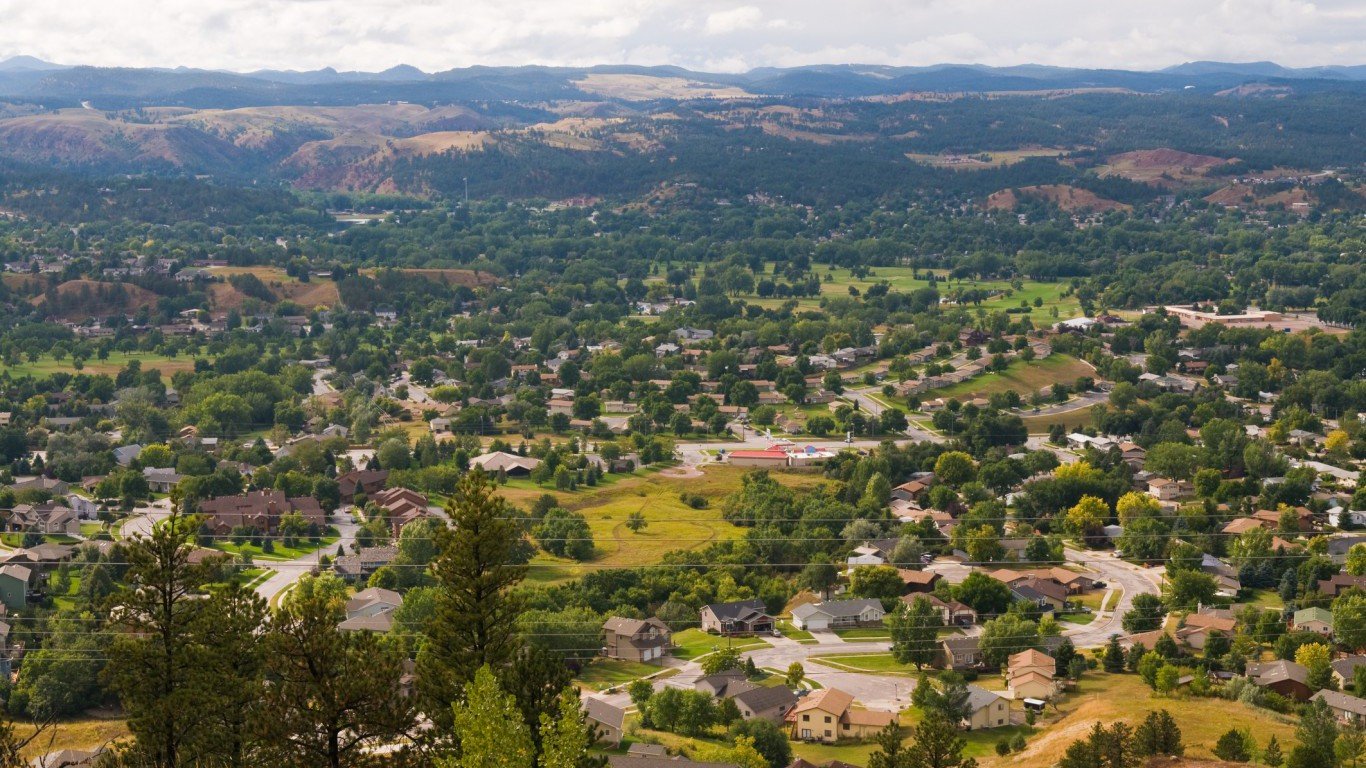
50. South Dakota
> Underemployment rate: 5.0%
> June unemployment rate: 2.7% (the lowest)
> Median wage: $30,780 (4th lowest)
> Labor force growth: 0.7% (17th smallest growth)
South Dakota is the best state for job seekers. The state’s June unemployment rate of 2.7% is the lowest of all states. While the official unemployment rate often fails to capture dissatisfied, underemployed workers, South Dakota’s underemployment rate of 5.0% is also the lowest of all states and nearly half the national underemployment rate of 9.9%. In South Dakota, both labor force measurements improved significantly from a year ago.
On the other hand, wages in the state are not especially high. The average worker earns just $30,780 annually, nearly the lowest of all states.
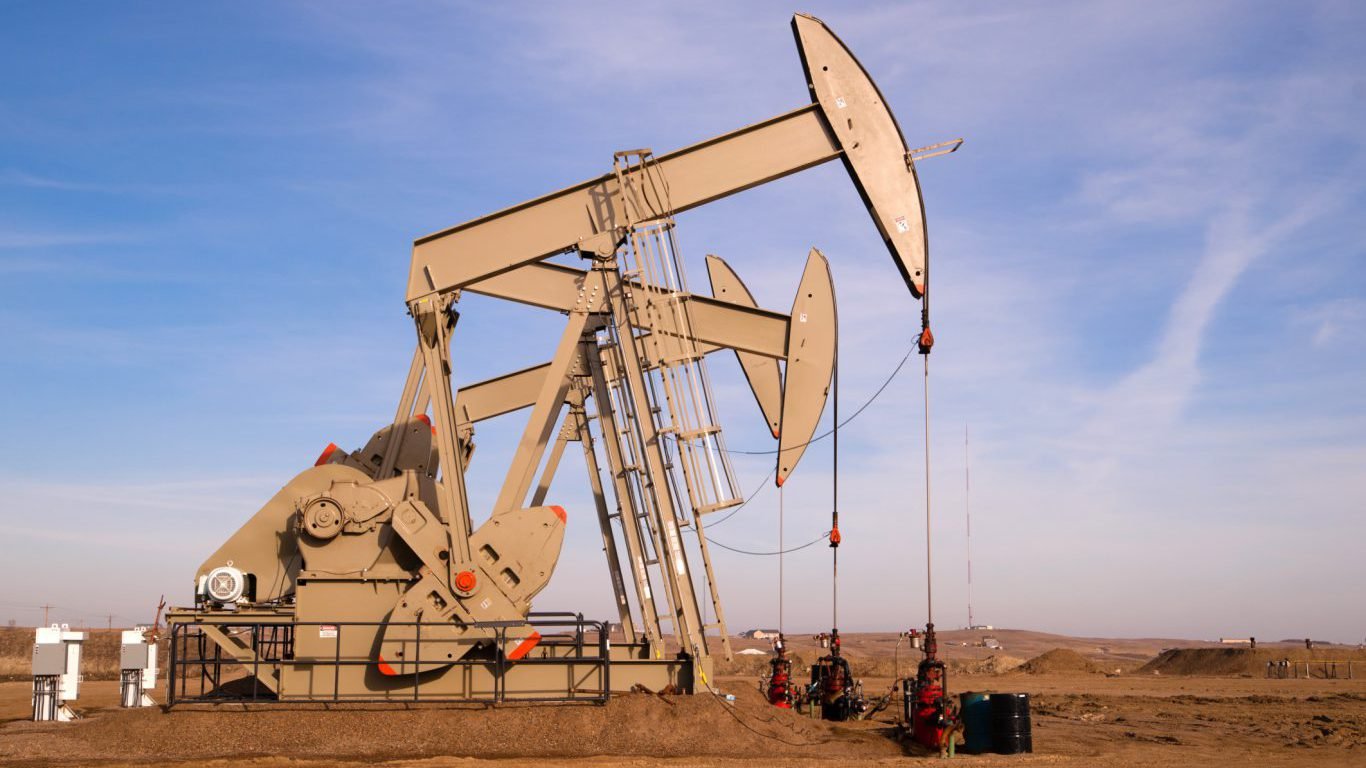
49. North Dakota
> Underemployment rate: 5.7%
> June unemployment rate: 3.2% (5th lowest
> Median wage: $38,170 (15th highest)
> Labor force growth: 1.3% (23rd largest growth)
Not many states fared better during the recession than North Dakota. Largely due to a booming oil industry, the North Dakota unemployment rate rose by less than half a percentage point between 2005 and 2010, the least of any state.
After a substantial decline in oil prices, however, the state’s growth has slowed meaningfully. The state’s labor force grew by just 1.3% over the last year, half its growth rate five years prior. Nevertheless, the state still has one of the most inclusive economies in the country today. Just 5.7% of all people willing and able to work in the state are underemployed, compared to a 9.9% underemployment rate nationwide.
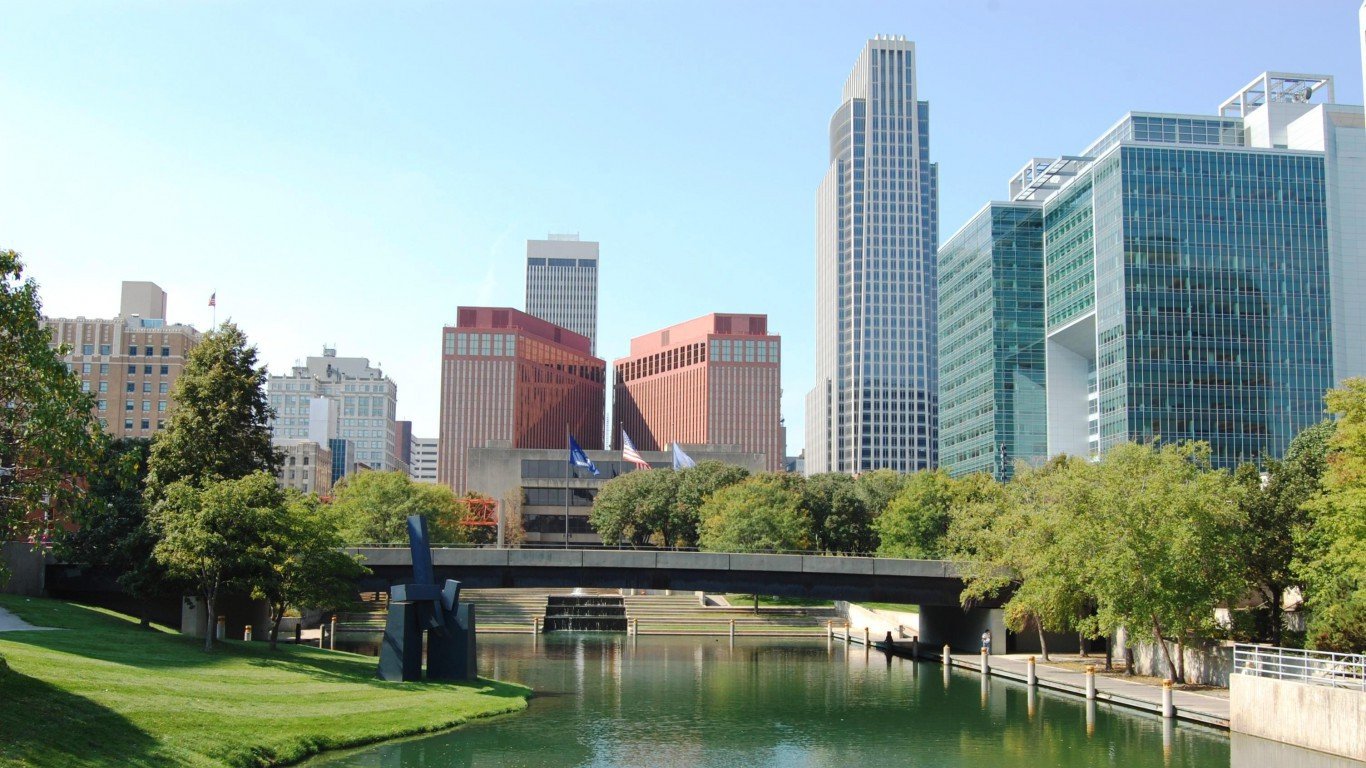
48. Nebraska
> Underemployment rate: 6.2%
> June unemployment rate: 3.0% (3rd lowest)
> Median wage: $33,840 (22nd lowest)
> Labor force growth: 0.8% (20th smallest growth)
Nebraska’s unemployment rate is among the lowest in the country. Just 3.0% of the labor force is unemployed, the third smallest share of any state. Nebraska’s low unemployment rate coincides with small shares of potential full-time workers who are discouraged from seeking work or who are settling for part-time jobs. In Nebraska 6.2% of all workers and potential workers are either unemployed, discouraged from seeking work, or working part-time when they would prefer to work full-time — the third lowest of any state.
The finance sector is much less likely to employ individuals part-time when they would prefer full-time jobs. Of the state’s total employment, 7.6% work in finance, the seventh highest share among all states.

47. Iowa
> Underemployment rate: 7.0%
> June unemployment rate: 4.0% (15th lowest)
> Median wage: $33,650 (19th lowest)
> Labor force growth: 0.7% (18th smallest growth)
Iowa’s job market is well-suited for those seeking full-time employment. Only 7.0% of adults in the state are unemployed, discouraged from seeking a job, or work part-time when a full-time job is preferred. The industries present in a state can meaningfully affect underemployment. Finance jobs, for example, are less likely to employ workers part-time when they would prefer full-time jobs.
The state’s finance and insurance sector, for example, employs 7.4% of the Iowa workforce, the eighth largest share nationwide. The state also has the smallest share of workers employed in the arts, entertainment, and recreation sector — industries which tend to have a high proportion of part-time employees.
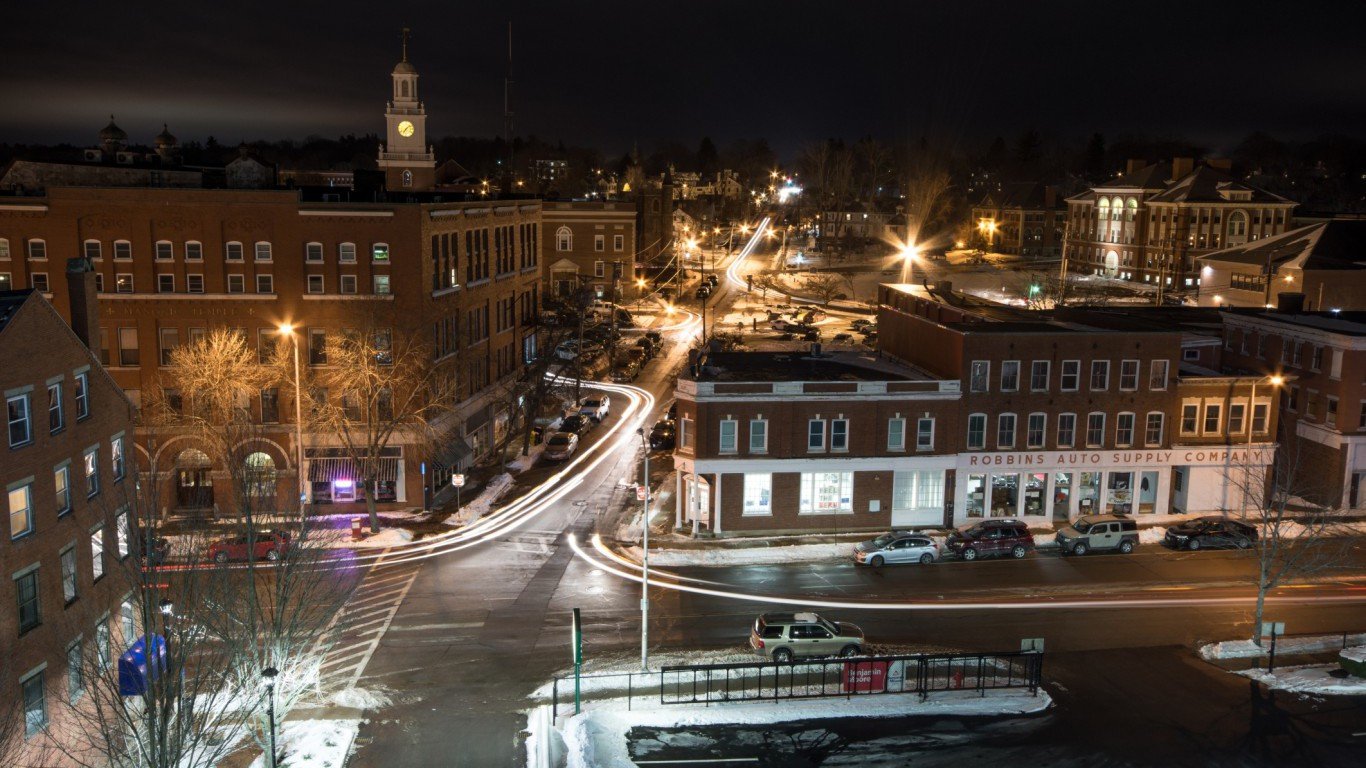
46. New Hampshire
> Underemployment rate: 7.2%
> June unemployment rate: 2.8% (2nd lowest)
> Median wage: $37,280 (18th highest)
> Labor force growth: 1.3% (24th largest growth)
Just 7.2% of New Hampshire’s willing and able workers are either unemployed or not employed to the extent that they would like.
As is the case with the vast majority of states with low underemployment, New Hampshire’s population tends to have high educational attainment. While 86.9% of U.S. adults graduated from high school, 92.2% of New Hampshire adults have done the same. Generally, higher employment tends to lead to higher household incomes and lower poverty. Just 9.2% of New Hampshire’s population lives below the poverty line, the lowest proportion in the country.
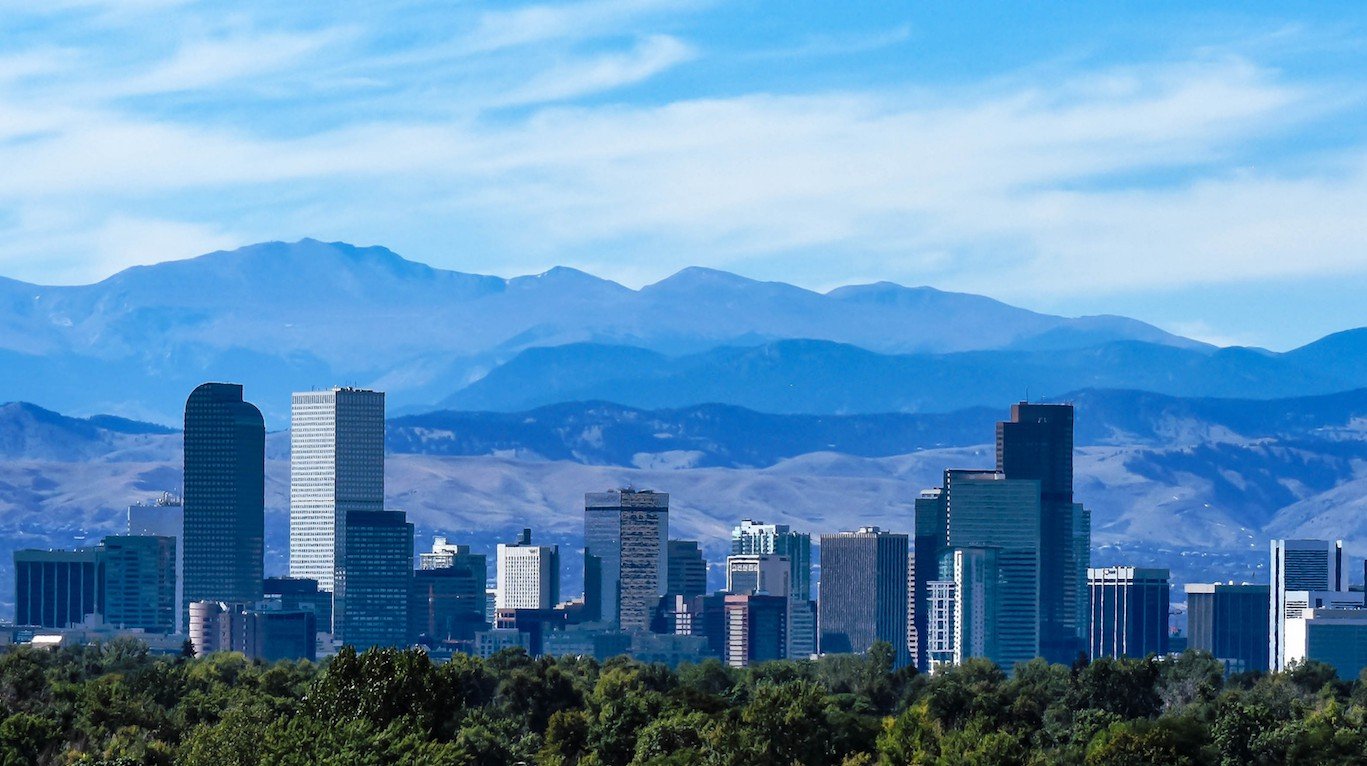
45. Colorado
> Underemployment rate: 7.3%
> June unemployment rate: 3.7% (10th lowest)
> Median wage: $38,800 (11th highest)
> Labor force growth: 2.8% (5th largest growth)
By many measures, Colorado has one of the most robust economies in the U.S. Between 2015 and 2016, the state’s labor force grew by 2.8%, the fifth fastest growth rate. Even as the number of job-seekers grew meaningfully in the state, unemployment went down over the same time period, dropping from 3.9% to 3.7%. In addition, only 3.3% of potential workers are forced to work in part-time positions when they would prefer full-time work. Nationwide, 3.8% of the same cohort is forced to accept part-time employment.
Fewer residents tend to be underemployed in states with greater high school attainment. More than 90% of adults in Colorado have a high school diploma, compared to the 86.9% of the nation’s adults who do.
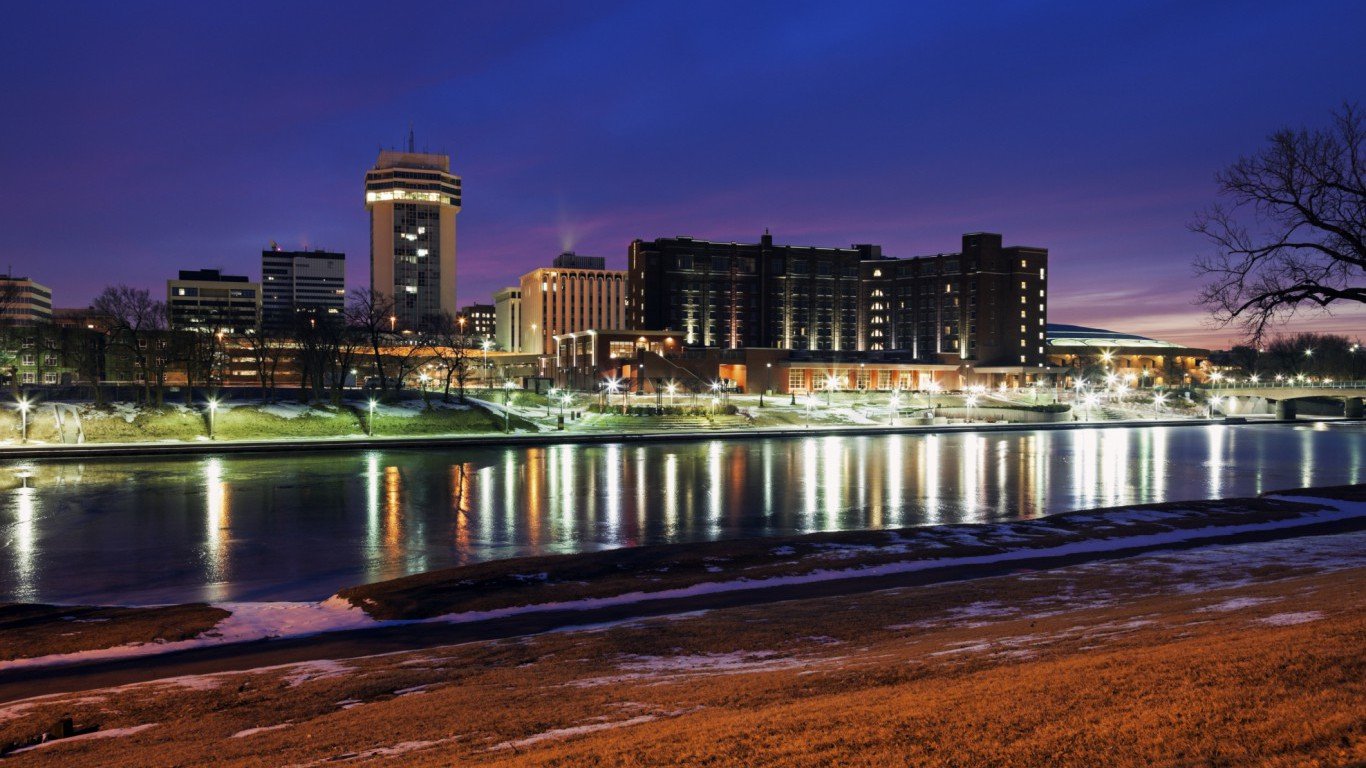
44. Kansas
> Underemployment rate: 7.8%
> June unemployment rate: 3.8% (tied–13th lowest)
> Median wage: $33,700 (21st lowest)
> Labor force growth: 0.2% (9th smallest growth)
The job market in Kansas has plenty to offer those seeking full-time work. Job seekers in the state are the least likely in the country to become discouraged and drop out of the labor force. Only 0.1% of the state’s willing and able workers would like a job but have given up looking — the corresponding national share of discouraged workers is four times what it is in Kansas. Furthermore, only 3.0% are forced to accept part-time rather than full-time work.
Even by more traditional economic measures, Kansas looks better than much of the rest of the country. Only 3.8% of the workforce is unemployed, compared to a 4.9% national unemployment rate.
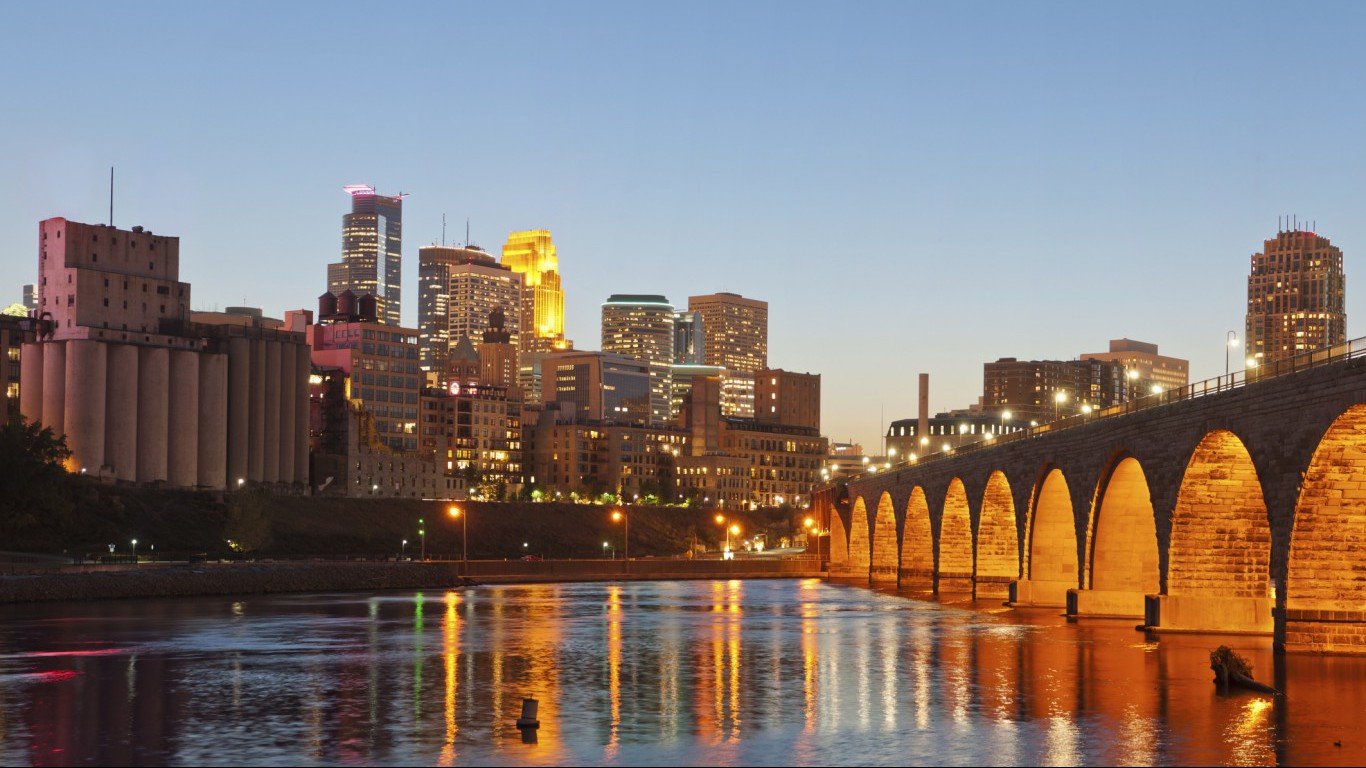
43. Minnesota
> Underemployment rate: 7.8%
> June unemployment rate: 3.8% (tied–13th lowest)
> Median wage: $38,870 (10th highest)
> Labor force growth: 1.2% (25th smallest growth)
Not only is a relatively small 7.8% of Minnesota’s potential pool of workers unemployed or underemployed, but the typical worker is paid more than those in most states. The state’s median annual wage of $38,870 is the 10th highest in the country.
As is the case for most states with low underemployment, Minnesota’s labor force participation is high. Nationally, 62.7% of eligible residents are either employed or actively seeking work. In Minnesota the rate is 70.5%, the highest labor force participation in the country.
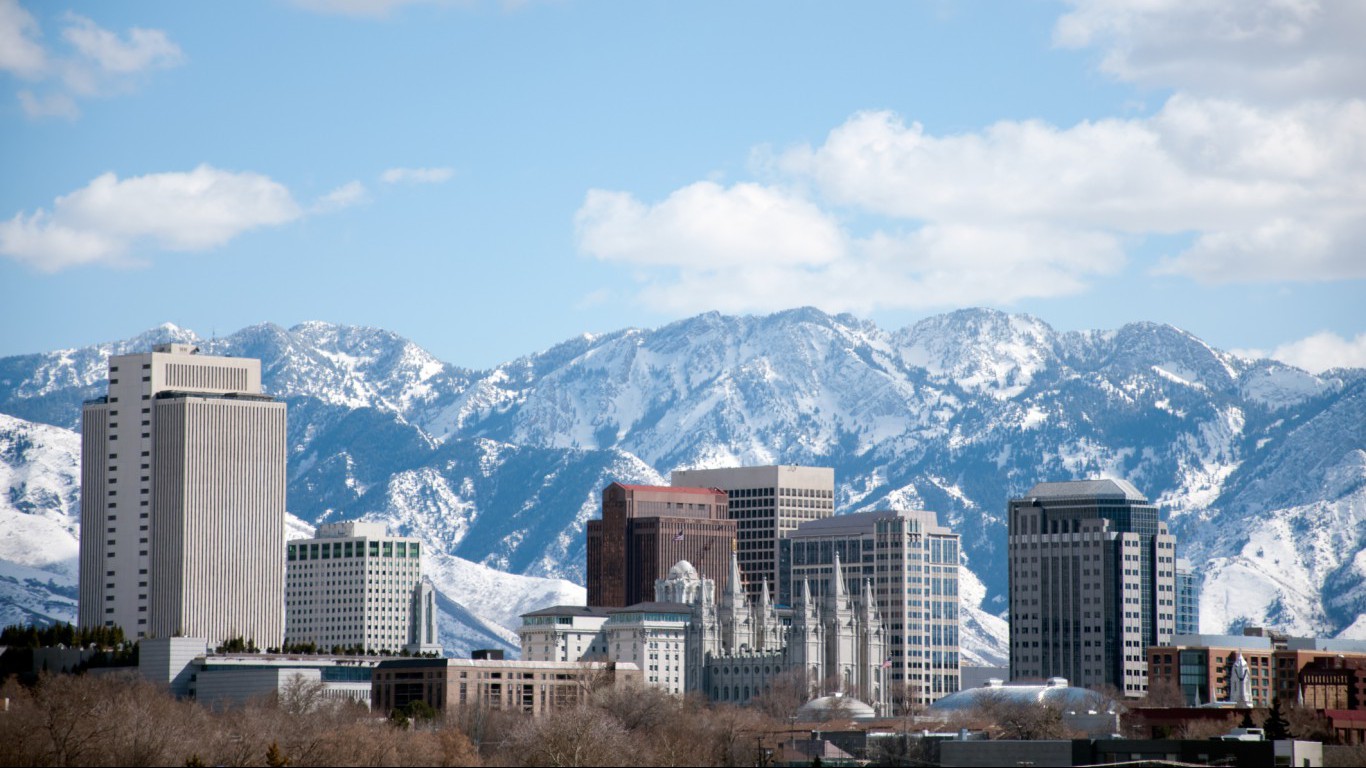
42. Utah
> Underemployment rate: 7.8%
> June unemployment rate: 4.0% (15th lowest)
> Median wage: $33,990 (23rd lowest)
> Labor force growth: 2.4% (10th largest growth)
Utah has one of the lowest underemployment rates of any state. Just 7.8% of all willing and able workers are unemployed, discouraged from seeking work, or working part-time for financial reasons. By comparison, the national underemployment rate is 9.9%.
Over the past year, the Utah labor force grew by 2.4%, twice the national growth rate. The state’s economy may not have been able to accommodate the new entrants, however. The unemployment rate rose from 3.6% to 4.0%, while in most of the country unemployment decreased.
[wallst_email_setup]

41. Vermont
> Underemployment rate: 8.1%
> June unemployment rate: 3.2% (5th lowest)
> Median wage: $37,040 (20th highest)
> Labor force growth: 0.5% (12th smallest growth)
Vermont’s economy weathered the recession remarkably well and has among the healthiest job markets by several measures. Vermont’s unemployment rate of 3.2% is close to the lowest in the country. The state’s high labor force participation rate, at 67.2%, together with low unemployment and underemployment, are all good signs of a healthy economy.
In Vermont, the low level of underemployment is also due to industry composition. Relatively high shares of Vermonters are employed in industries containing few part-time jobs. For example, close to 30% of the state’s workforce is employed by the education and health care industry, the highest of all states.

40. Missouri
> Underemployment rate: 8.2%
> June unemployment rate: 4.5% (23rd lowest)
> Median wage: $33,380 (17th lowest)
> Labor force growth: 1.1% (24th smallest growth)
Decreasing half a percentage point from last year, Missouri’s unemployment rate of 4.5% is slightly lower than the 4.9% national rate. The state’s underemployment rate, which includes unemployment as well as discouraged workers and unwilling part-time workers, is 8.2%. While several states have less labor underutilization than Missouri, the state’s 2016 underemployment figure marks a 2.5 percentage point improvement over the year before. This was one of the most precipitous drops of any state.
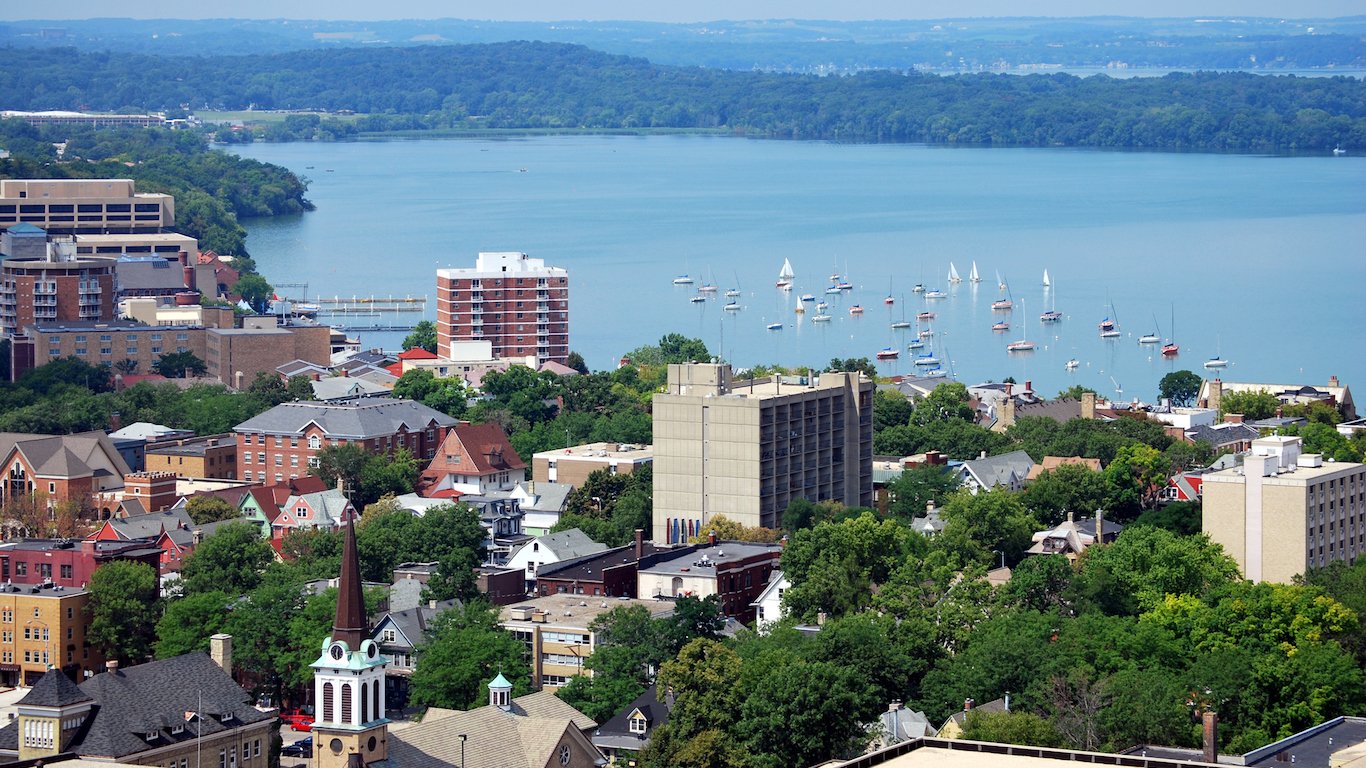
39. Wisconsin
> Underemployment rate: 8.2%
> June unemployment rate: 4.2% (20th lowest)
> Median wage: $35,110 (23rd highest)
> Labor force growth: 1.5% (21st largest growth)
Wisconsin’s unemployment rate of 4.2% and underemployment rate of 8.2% are each below the national figures of 4.9% and 9.9%, respectively. Economies where a disproportionately high share of people in the labor force are able to work as much as they want tend to have fewer people give up on finding work. This is certainly the case for Wisconsin, which has a labor force participation rate of 68.5%, the seventh highest in the country.
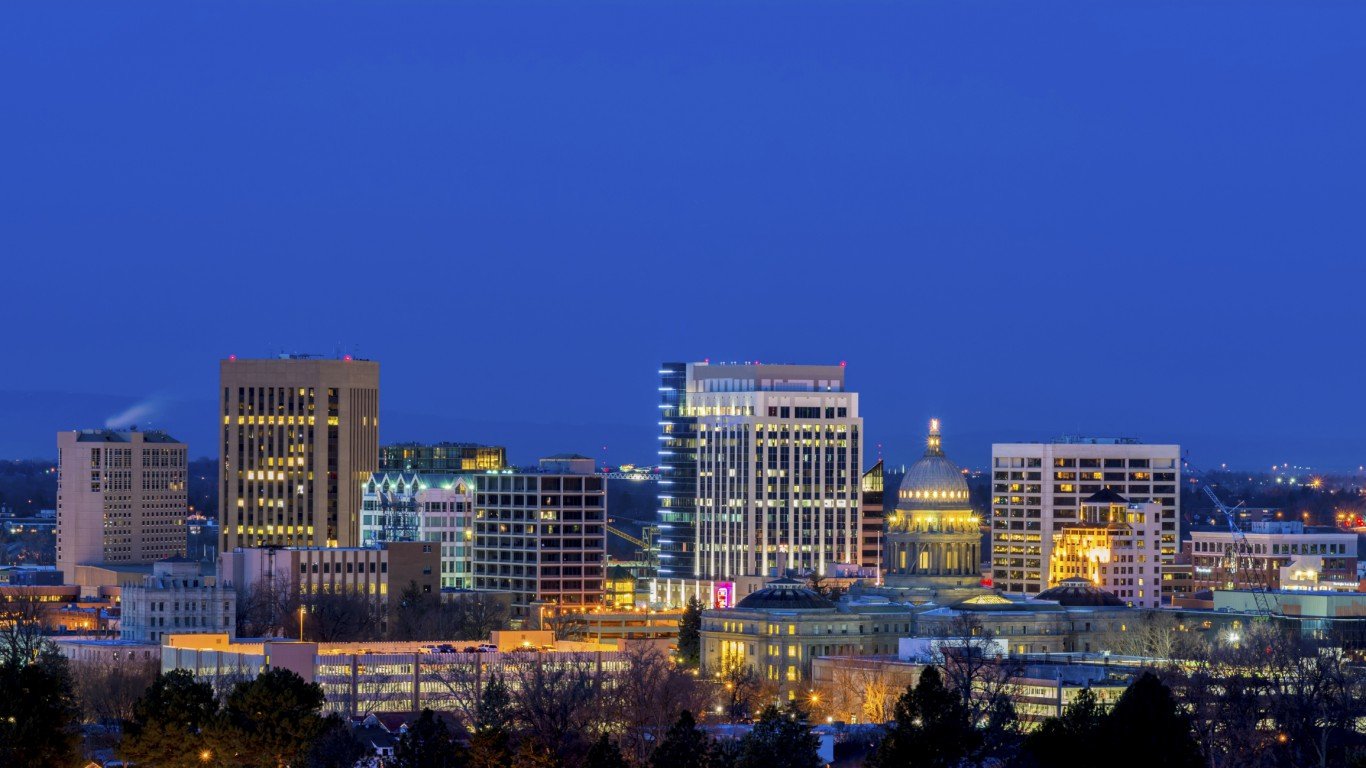
38. Idaho
> Underemployment rate: 8.3%
> June unemployment rate: 3.7% (10th lowest)
> Median wage: $31,860 (9th lowest)
> Labor force growth: 1.7% (18th largest growth)
Just over 64% of Idaho’s population participates in the labor force, a slightly larger share than is typical across the country. Even with greater participation, the state’s economy is equipped to provide a higher-than-average percentage of willing workers with jobs. Only 8.3% of people in the state who want jobs are either out of work or forced to accept part-time employment. The corresponding national share is 9.9%.
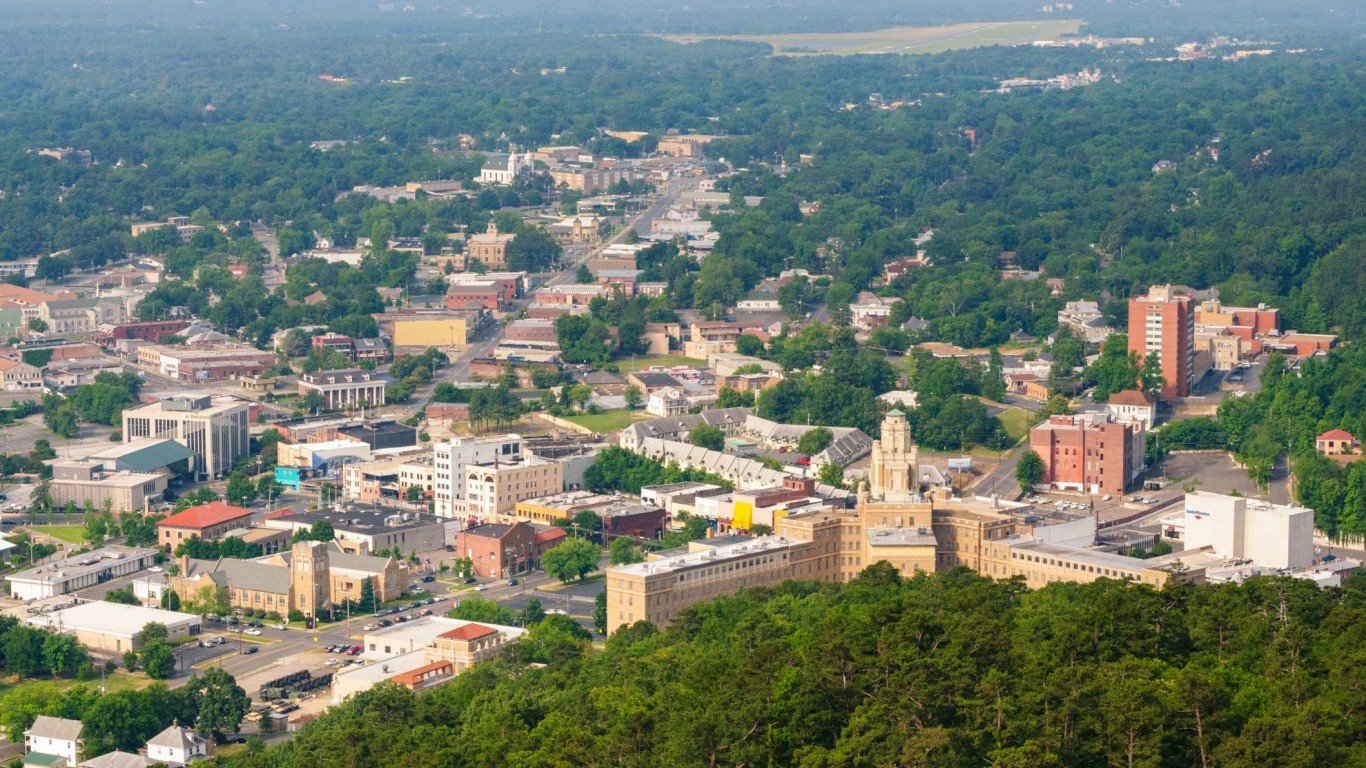
37. Arkansas
> Underemployment rate: 8.4%
> June unemployment rate: 3.8% (13th lowest)
> Median wage: $29,420 (2nd lowest)
> Labor force growth: 2.3% (11th largest growth)
In 2015, Arkansas’ 5.3% unemployment rate was exactly in line with that of the country as a whole. However, in the past year, unemployment in the state has gone down by 1.5 percentage points, the second most precipitous drop of any state. Today, only 3.8% of the state’s workforce is without a job and actively seeking one, far smaller than the national 4.9% unemployment rate. The states underemployment rate of 8.4% is also considerably less than the corresponding 9.9% national rate, meaning people in the state are less likely to be discouraged from remaining in the labor force and less likely to be forced to take part-time work in lieu of full-time employment.
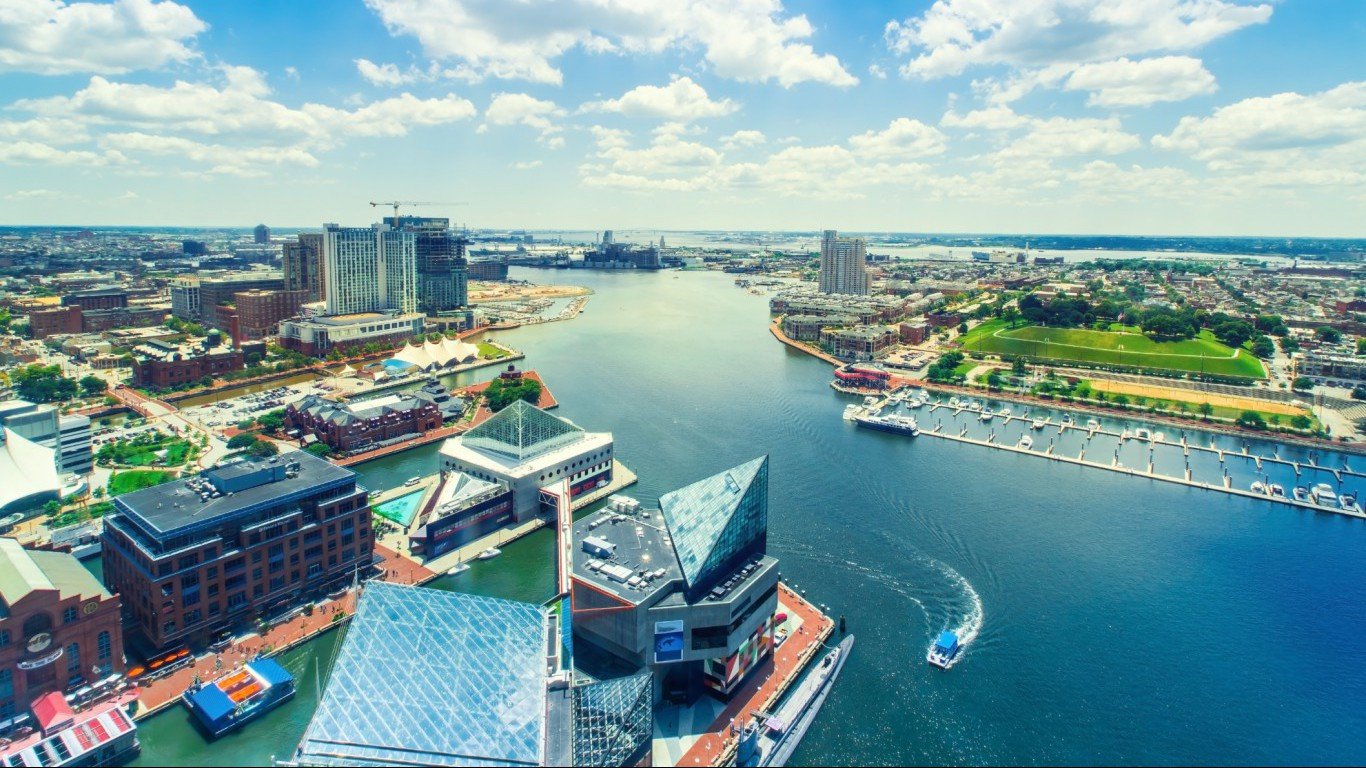
36. Maryland
> Underemployment rate: 8.4%
> June unemployment rate: 4.3% (21st lowest)
> Median wage: $41,860 (5th highest)
> Labor force growth: 0.7% (16th smallest growth)
Just 2.8% of all Maryland workers have part-time jobs instead of full-time positions for economic reasons, the fifth smallest share of any state. Maryland’s industry composition may help explain the small share of involuntary part-time workers. The professional services industry is far less likely to have a part-time position for someone who wants to work full-time, and employs 14.9% of the Maryland workforce — the highest share of any state. Maryland also has the smallest share of workers employed in retail in the country, one of the worst sectors for involuntary part-time work. Maryland’s 8.4% overall underemployment rate is one of the lowest in the country.
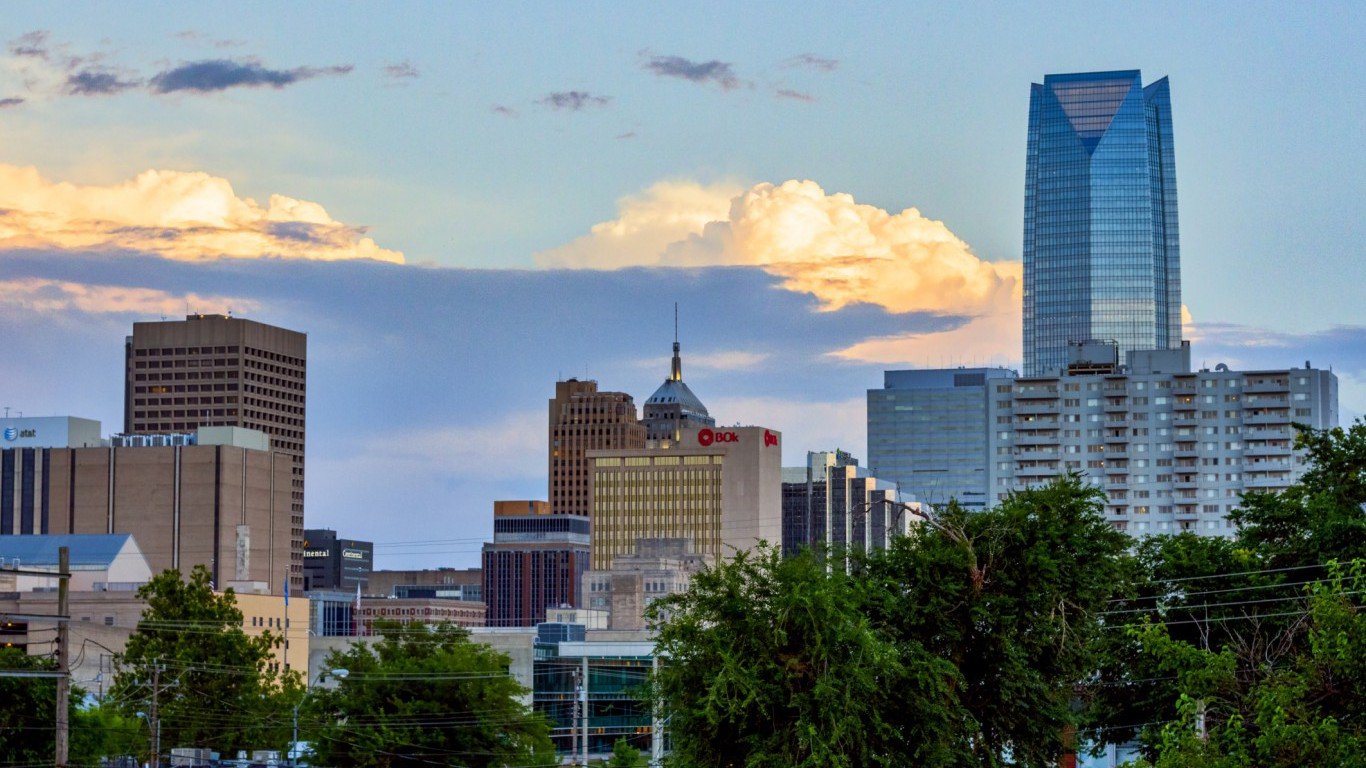
35. Oklahoma
> Underemployment rate: 8.5%
> June unemployment rate: 4.8% (22nd highest)
> Median wage: $32,430 (14th lowest)
> Labor force growth: 0.4% (11th smallest growth)
Only 2.9% of the active and potential workers in Oklahoma is forced to work part-time, one of the smallest such shares of any state in the country. The total 8.5% share of underemployed in the state is far lower than the corresponding 9.9% nationwide share. Unlike most states with low underemployment, however, the unemployment rate is climbing in Oklahoma. After increasing 0.4 percentage points over the past year, Oklahoma’s 4.8% unemployment rate is slightly below the national rate.

34. Texas
> Underemployment rate: 8.5%
> June unemployment rate: 4.5% (23rd lowest)
> Median wage: $34,550 (24th lowest)
> Labor force growth: 2.0% (15th largest growth)
Over the past decade, no state has added more workers than Texas. Between 2005 and 2015, state employment increased by 18.7%, or nearly 2 million jobs. A substantial part of this growth occurred over the past five years, while most state economies were recovering from the recession. While some states that have added a significant number of post-recession jobs maintain higher-than-average underemployment, just 8.5% of Texas’ willing and able workers are either unemployed or underemployed, lower than the national rate of 9.9%.

33. Hawaii
> Underemployment rate: 8.7%
> June unemployment rate: 3.3% (6th lowest)
> Median wage: $38,750 (12th highest)
> Labor force growth: 1.3% (25th largest growth)
Hawaii has one of the most favorable job markets in the country, with among the lowest underemployment and unemployment rates, at 8.7% and 3.3%, respectively. Unlike other states with such healthy labor markets, however, Hawaii is home to a relatively high share of workers employed part-time for economic reasons, at 4.1%.
Due in part to the nation-leading cost of living in Hawaii, which is driven by steep housing costs, wages in Hawaii are also high. The average worker earns $38,750 annually, the 12th highest of all states.
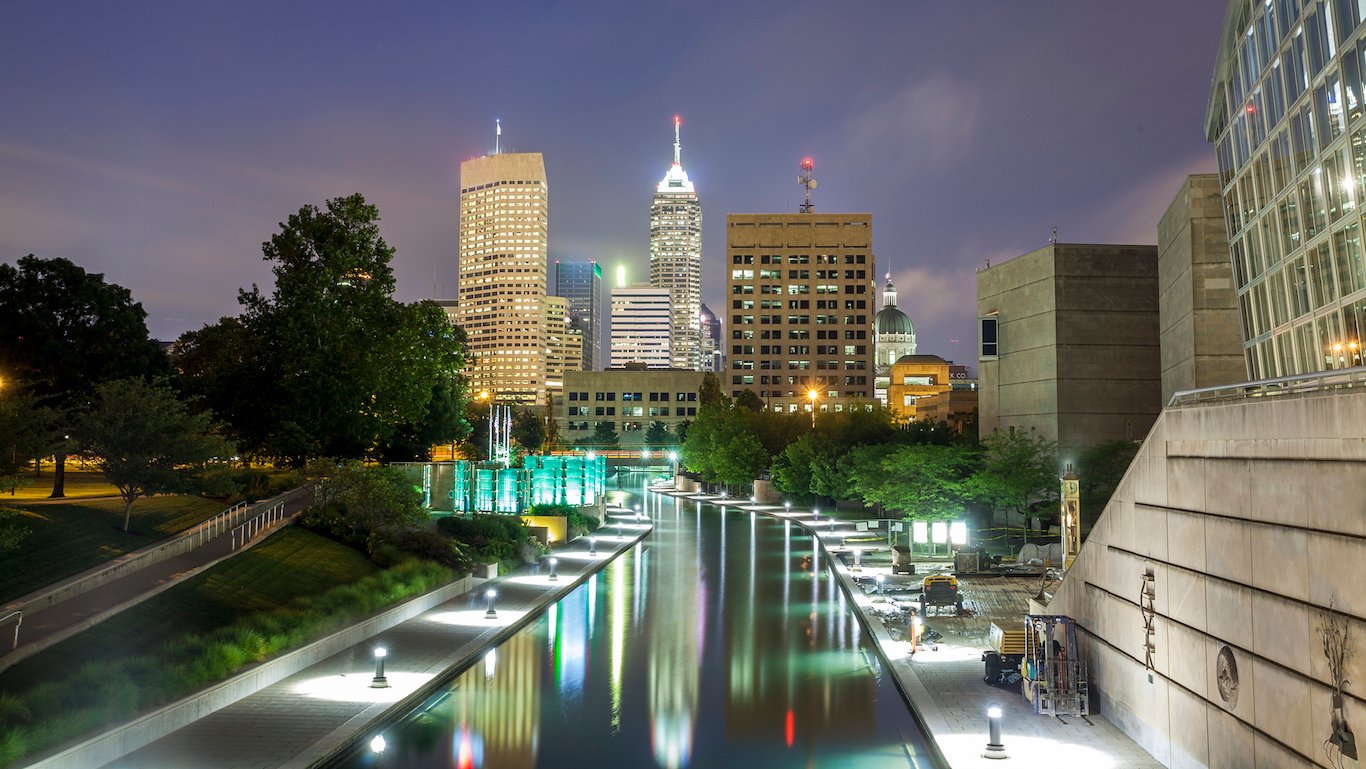
32. Indiana
> Underemployment rate: 8.7%
> June unemployment rate: 4.8% (22nd highest)
> Median wage: $32,910 (15th lowest)
> Labor force growth: 3.4% (3rd largest growth)
Between June 2015 and June 2016, Indiana’s labor force grew by 3.4%, the third largest increase in the country. Often, a growing labor force means increased competition for jobs. Over the same time period, unemployment in the state climbed a tenth of a percentage point to 4.8%. Still, at 8.7%, underemployment is less common in Indiana than it is across the country as a whole. Nationwide, 9.9% of people who want or are able to work are either out of work or forced to accept part-time positions.

31. Delaware
> Underemployment rate: 8.8%
> June unemployment rate: 4.2% (tied–20th lowest)
> Median wage: $37,750 (16th highest)
> Labor force growth: 3.4% (2nd largest growth)
Compared to other industries, relatively few jobs in the financial sector are part-time, and in Delaware, 9.8% of the workforce is employed in finance, the largest share of any state in the country. Partially as a result of this, only 3.4% of workers are forced to accept part-time instead of full-time employment, less than the corresponding 3.8% national share. Perhaps not surprisingly, the state’s economy is relatively strong. In the last year, unemployment dropped 0.7 percentage points to 4.2%, even as competition for jobs increased as the labor force grew by a near nation-leading pace of 3.4%.
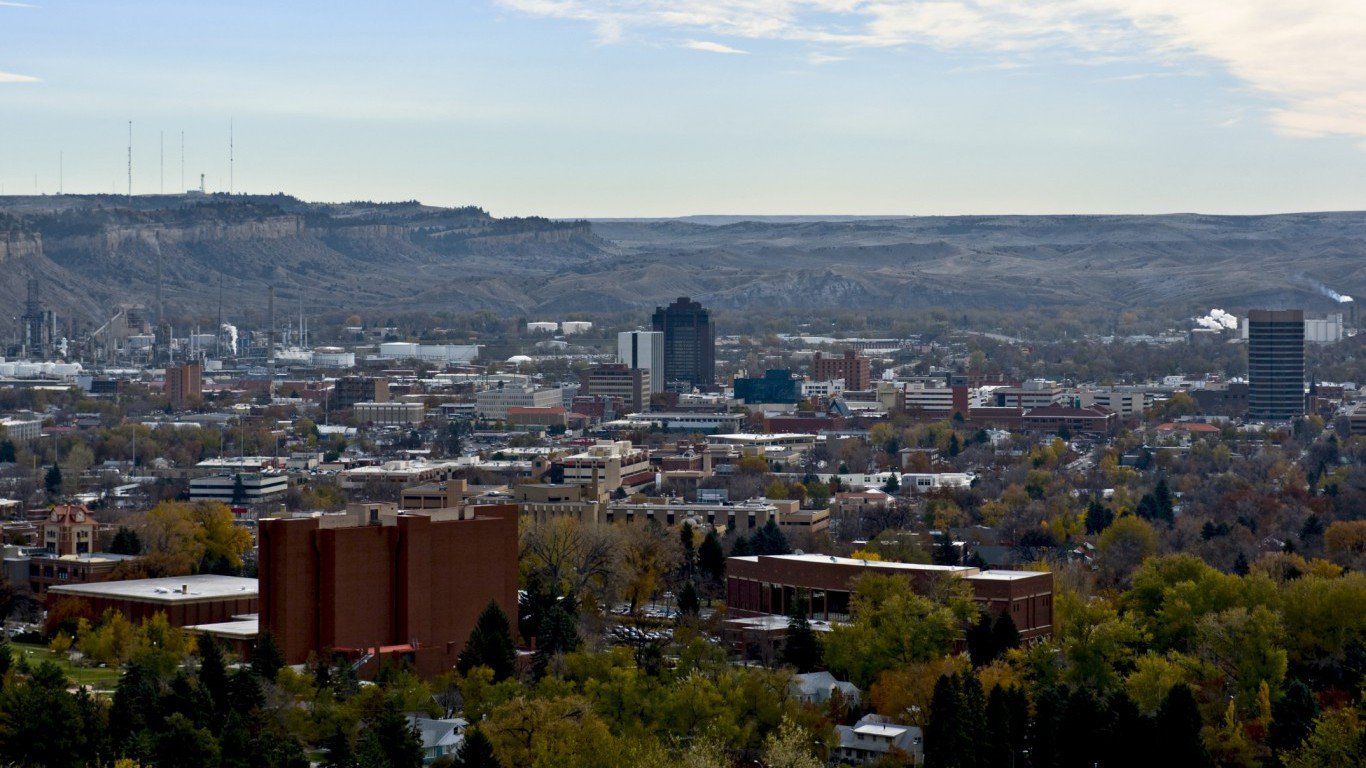
30. Montana
> Underemployment rate: 8.8%
> June unemployment rate: 4.2% (tied–20th lowest)
> Median wage: $31,970 (10th lowest)
> Labor force growth: 0.2% (8th smallest growth)
Of workers in Montana, including those who have given up their job search, 8.8% are either unemployed or working part-time against their preference, slightly less than the national rate of 9.9%. In the past year, a number of states have seen either unemployment or underemployment improve meaningfully, but Montana’s job market has remained stagnant. The state unemployment rate remained roughly unchanged over the past year. Meanwhile, the state’s share of workers who have either given up looking for work or are working part-time when they want to be working full-time remained level with the previous year.

29. Maine
> Underemployment rate: 9.0%
> June unemployment rate: 3.7% (tied–10th lowest)
> Median wage: $34,710 (25th highest)
> Labor force growth: 0.2% (10th smallest growth)
In Maine 9.0% of all workers are either unemployed, discouraged from seeking work, or are working at a part-time job instead of a full-time position for economic reasons. This is lower than the national 9.9% underemployment rate. While the state’s labor force remained relatively unchanged over the past year, the share of potential workers lacking full-time jobs has not. Maine’s underemployment fell by 2.1 percentage points over the last year, one of the largest declines in the country. The improvement was largely due to a substantial decrease in unemployment in the state.
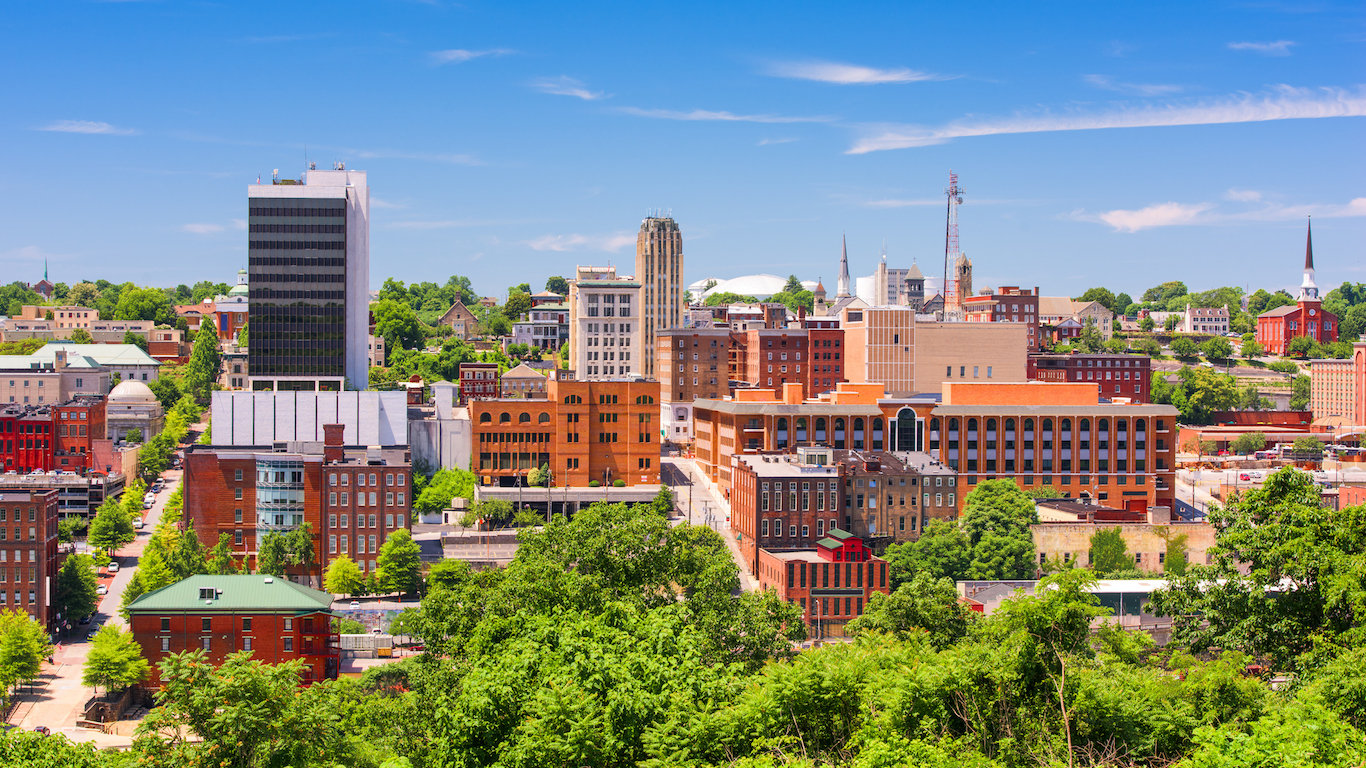
28. Virginia
> Underemployment rate: 9.3%
> June unemployment rate: 3.7% (tied–10th lowest)
> Median wage: $38,180 (14th highest)
> Labor force growth: -0.5% (5th largest decline)
Virginia’s 9.3% share of unemployed, underemployed, and discouraged workers is lower than the corresponding 9.9% national share. Still, a disproportionate number of workers in the state are forced to take part-time work due to a lack of full-time opportunities. In Virginia, 4.2% of workers are forced to take part-time positions, slightly more than the 3.8% national share. Still, the state’s 3.7% unemployment rate is one of the lowest in the country and well below the 4.9% national rate.

27. Massachusetts
> Underemployment rate: 9.4%
> June unemployment rate: 4.2% (20th lowest)
> Median wage: $45,580 (2nd highest)
> Labor force growth: 0.7% (15th smallest growth)
The Massachusetts underemployment rate of 9.4% is roughly in line with the national rate of 9.9%. Even considering the state’s 3.8% share of involuntary part-time workers, Massachusetts workers are paid more than most. The state’s median annual wage of $45,580 is higher than every state but Alaska.

26. Ohio
> Underemployment rate: 9.5%
> June unemployment rate: 5.0% (19th highest)
> Median wage: $35,030 (24th highest)
> Labor force growth: 2.0% (14th largest growth)
Ohio’s economy is faring only slightly better than the country’s in a few key employment measures. The state’s 9.5% underemployment rate is slightly less than the corresponding 9.9% national figure. Relatively rapid labor force growth likely translates to a more competitive job market. Between 2015 and 2016, Ohio’s labor force grew by 2.0%, faster than the majority of states and above the 1.2% national rate.
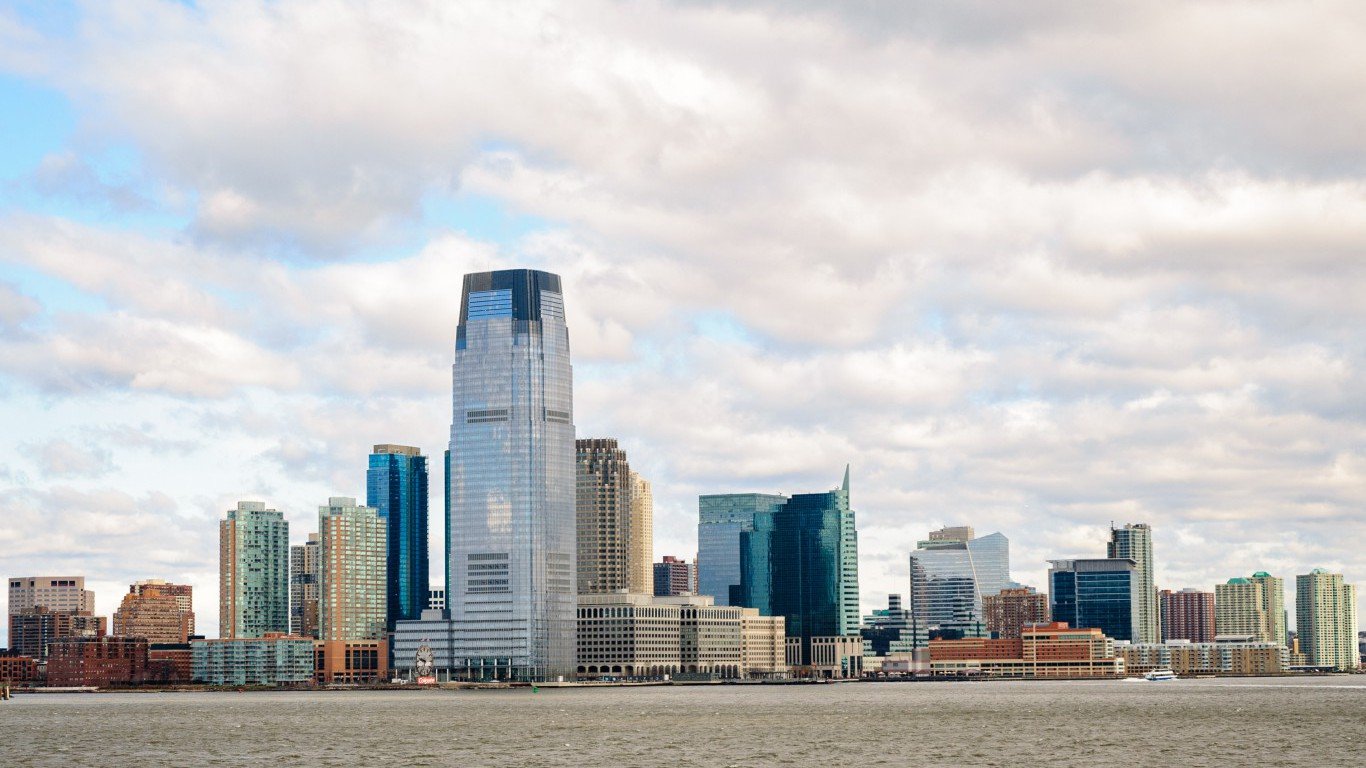
25. New Jersey
> Underemployment rate: 9.6%
> June unemployment rate: 5.1% (17th highest)
> Median wage: $41,320 (7th highest)
> Labor force growth: 0.9% (23rd smallest growth)
In New Jersey, 9.6% of all willing workers are unemployed, discouraged from seeking work, or settling for a part-time job for economic reasons — down substantially from 11.9% the year before. Along with this improvement, New Jersey enjoyed decreased unemployment, as well as significantly fewer residents working part-time jobs instead of full-time jobs due to economic constraints.
Nearly every industry in New Jersey expanded over the last year. The trade, transportation, and utilities sector accounted for nearly a third of the growth, adding 20,800 workers.

24. Wyoming
> Underemployment rate: 9.6%
> June unemployment rate: 5.7% (12th highest)
> Median wage: $38,280 (13th highest)
> Labor force growth: -2.3% (the largest decline)
An estimated 9.6% of Wyoming’s residents who want and are able to work are unable to do so, or are forced to work part-time when they would prefer full-time jobs. This figure, roughly in line with the national underemployment rate of 9.9%, represents a substantial increase from 12 months prior, when the state’s underemployment rate was 7.7%, the fourth lowest in the country. This nearly 2 percentage point increase was the largest of any state.
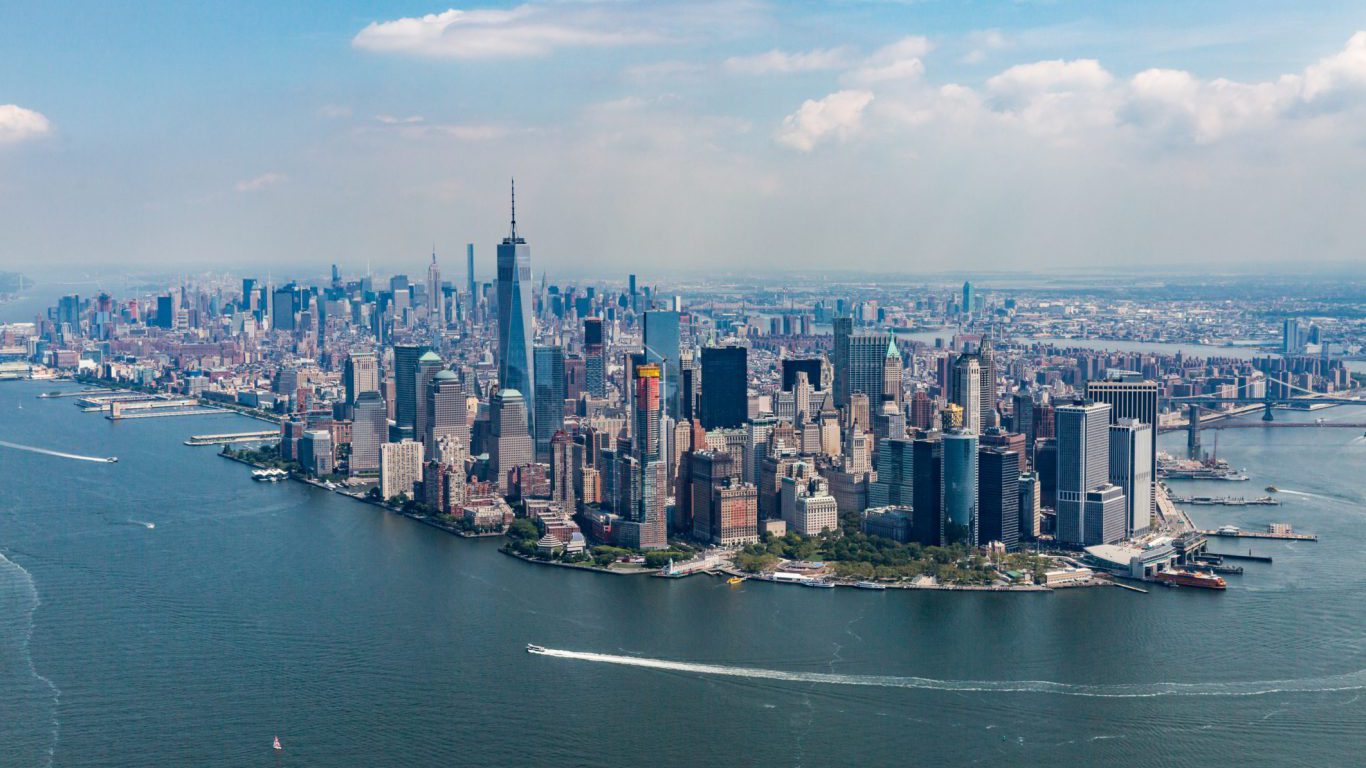
23. New York
> Underemployment rate: 9.8%
> June unemployment rate: 4.7% (25th highest)
> Median wage: $41,600 (6th highest)
> Labor force growth: 0.0% (7th smallest growth)
Over the past year, the number of New York state residents participating in the workforce remained effectively unchanged. However, the number of available jobs in the state increased as unemployment remained roughly unchanged at 4.7%. The total share of state residents who are underserved by the job market, including those who are too discouraged to look for work and those who are forced to accept part-time against their preference for full-time work is 9.8%, roughly in line with the corresponding national share.
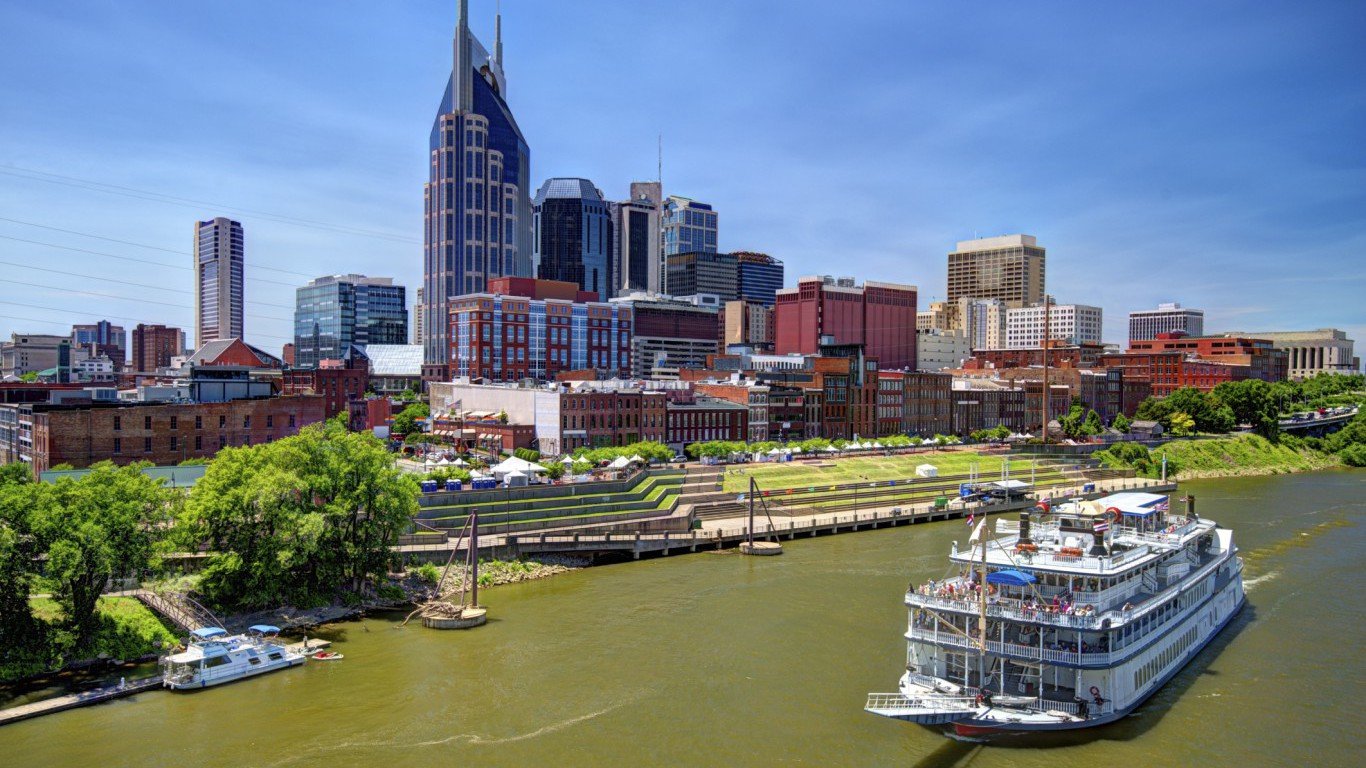
22. Tennessee
> Underemployment rate: 9.8%
> June unemployment rate: 4.1% (16th lowest)
> Median wage: $31,820 (8th lowest)
> Labor force growth: 2.6% (7th largest growth)
Tennessee’s unemployment rate improved by 1.6 percentage points in the past 12 months, more than any other state. While its unemployment rate of 4.1% now falls below the national rate of 4.9%, the state’s underemployment rate of 9.8% is in line with the national underemployment rate of 9.9%. As is the case with many states with underemployment similar to or higher than the national rate, incomes tend to be lower in Tennessee. The state’s median annual wage of $31,820 is the eighth lowest among all states.
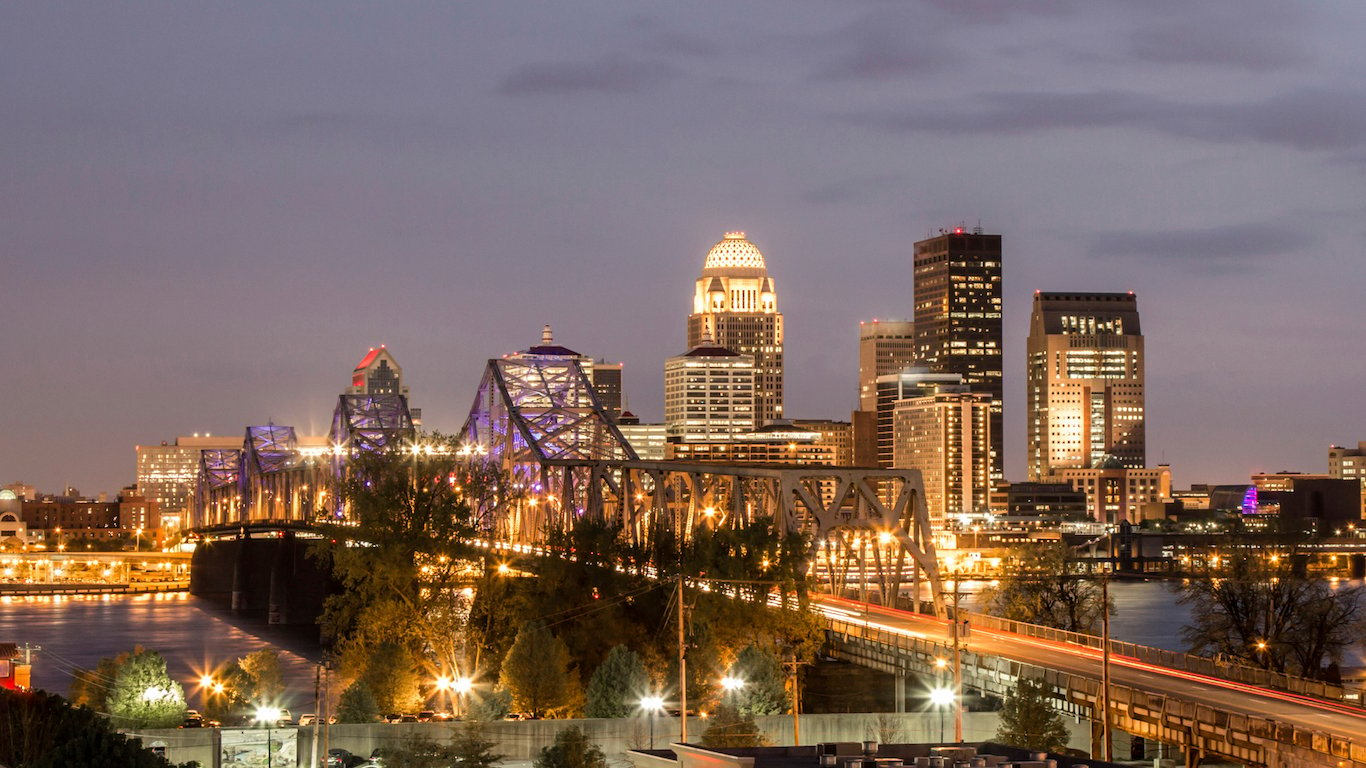
21. Kentucky
> Underemployment rate: 10.0%
> June unemployment rate: 5.0% (19th highest)
> Median wage: $32,340 (13th lowest)
> Labor force growth: 1.6% (20th largest growth)
With lower-than-average labor force participation and higher-than-average unemployment and underemployment, Kentucky’s economy is worse than most other states’. Only 57.1% of the state’s population actively participates in the labor force, one of the lowest rates in the country. Such a small workforce relative to the population often means higher numbers of people have given up looking for work and dropped out of the labor force, driving up the underemployment rate. However, Kentucky’s underemployment in roughly in line with the national rate.
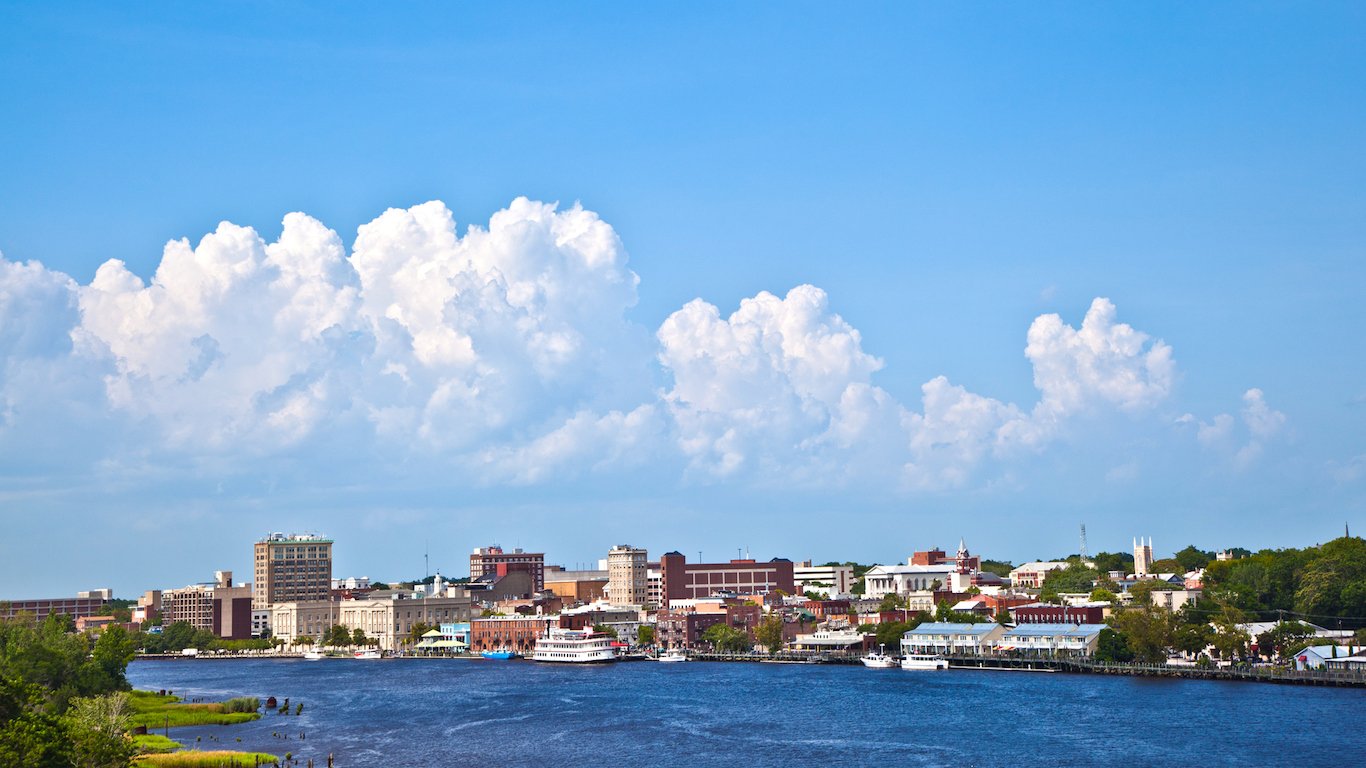
20. North Carolina
> Underemployment rate: 10.2%
> June unemployment rate: 4.9% (21st highest)
> Median wage: $33,100 (16th lowest)
> Labor force growth: 2.0% (13th largest growth)
Between June 2015 and June 2016 unemployment improved slightly in North Carolina, falling from 5.8% to 4.9%. This was a larger improvement than the national decline. The change came despite increased competition as labor force participation grew by 2.0% over the same time period. Despite the improvement, 10.2% of workers and those too discouraged to keep looking for work are underserved by the state’s job market, a larger share than in the majority of states.
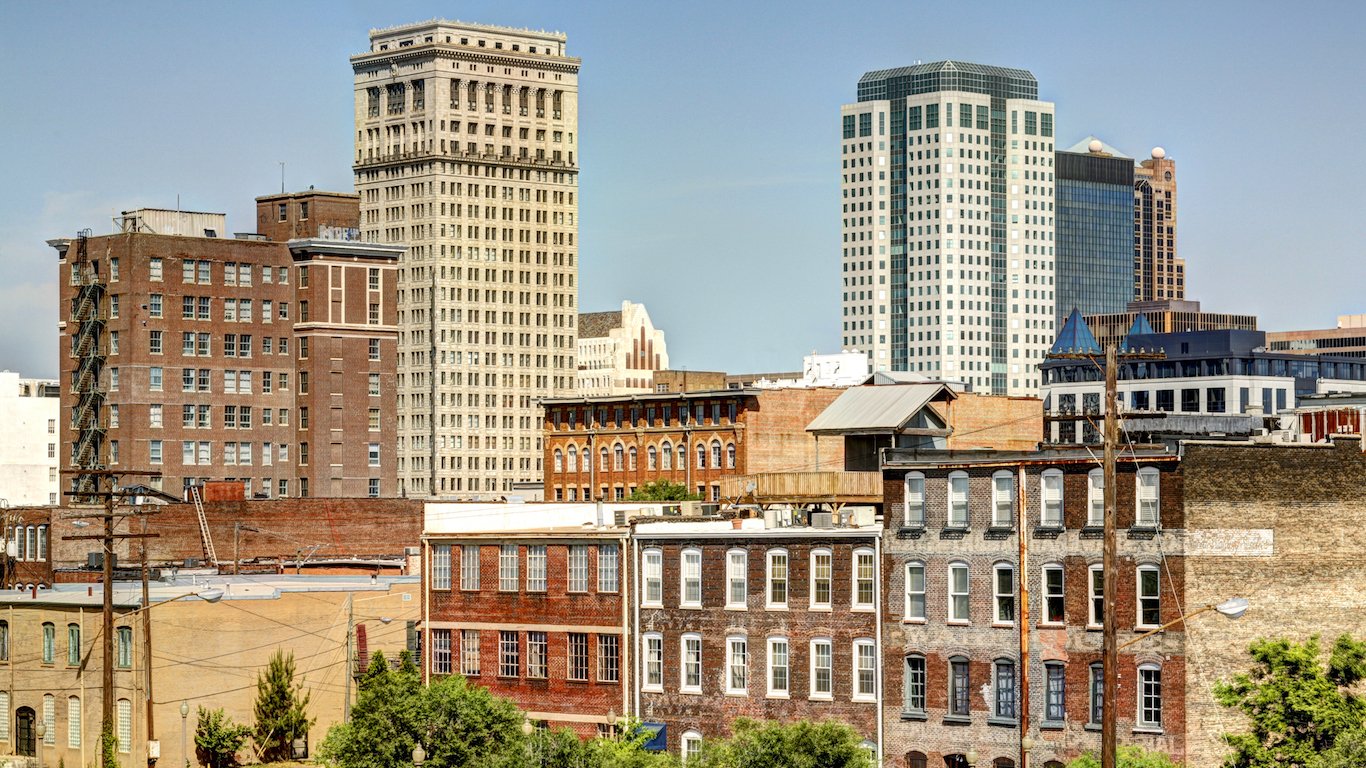
19. Alabama
> Underemployment rate: 10.3%
> June unemployment rate: 6.0% (6th highest)
> Median wage: $31,550 (6th lowest)
> Labor force growth: 1.6% (19th largest growth)
Alabama’s underemployment rate of 10.3% is higher than the national rate of 9.9%. However, a disproportionately high share of the state’s underemployed fall into the traditional definition of unemployed, rather than those who have given up looking for work entirely or are working part-time against their will. The state’s unemployment rate of 6.0% is the sixth highest in the country. Meanwhile, only 3.1% of Alabama’s civilian labor force, plus marginally attached workers, work part-time when they would prefer to work full-time, the 10th lowest figure nationwide.

18. Rhode Island
> Underemployment rate: 10.3%
> June unemployment rate: 5.5% (14th highest)
> Median wage: $39,050 (9th highest)
> Labor force growth: -0.5% (4th largest decline)
Over the last year, the Rhode Island labor force contracted by 0.5%, while the national labor force grew by 1.2%. Many of those leaving the labor force may have been among the unemployed, as the unemployment rate fell from 6.0% to 5.5% over the same period. The total number of workers rose, with the professional and business services sector adding the most employees. The underemployment rate also fell from 12.4% to 10.3%, one of the most substantial improvements in the country. The change was largely due to falling unemployment and a decrease in the share of workers settling for part-time jobs due to economic constraints.
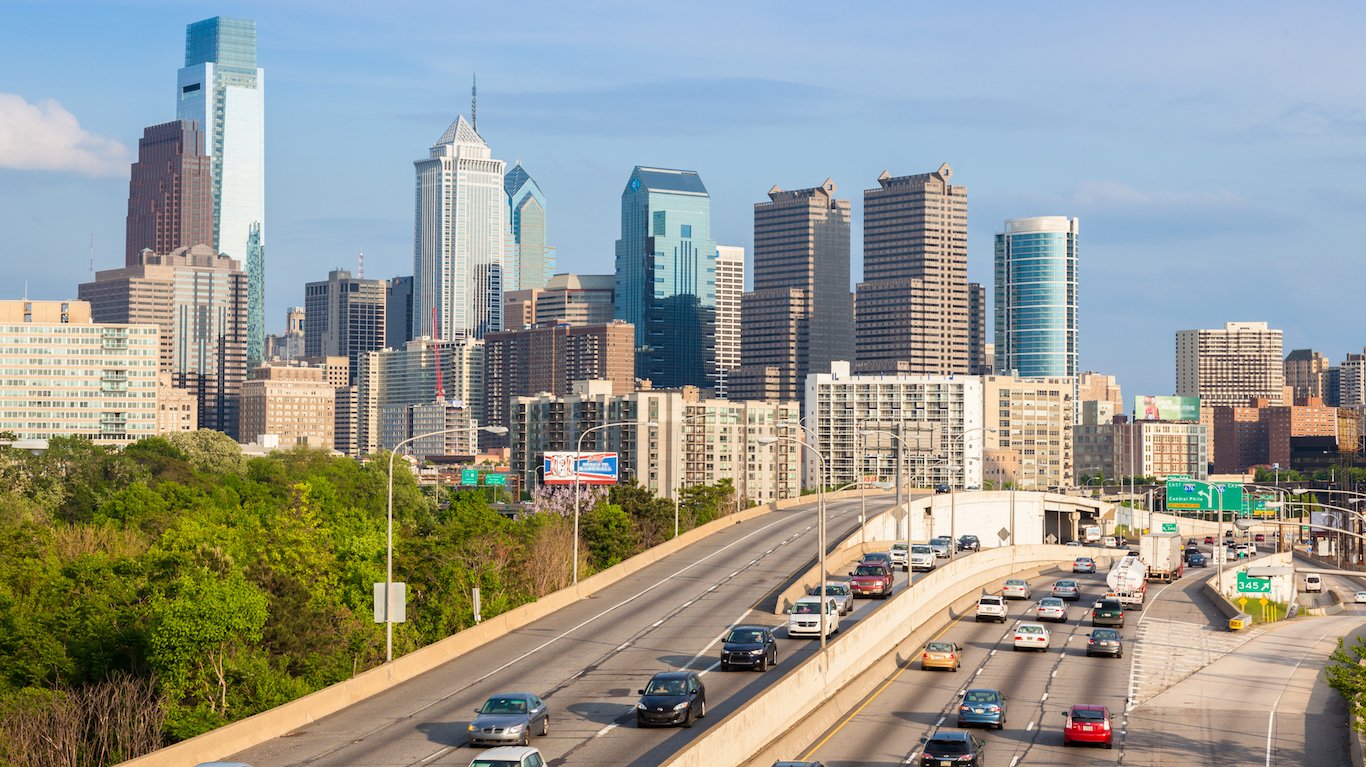
17. Pennsylvania
> Underemployment rate: 10.5%
> June unemployment rate: 5.6% (13th highest)
> Median wage: $36,150 (21st highest)
> Labor force growth: 1.8% (17th largest growth)
Over last year, the Pennsylvania labor force grew by 1.8%, slightly faster than the nation as a whole. The Pennsylvania economy may not have been able to accommodate the new entrants, however, as the unemployment rate rose from 5.1% to 5.6% over the same period — the second largest increase of any state. In addition to high unemployment, Pennsylvania has a relatively large share of involuntary part-time workers. Of all willing and able workers in the state, 10.5% are either unemployed, discouraged from seeking work, or working at a part-time job instead of a full-time position for economic reasons, one of the higher underemployment rates nationwide.

16. Florida
> Underemployment rate: 10.6%
> June unemployment rate: 4.7% (25th highest)
> Median wage: $31,810 (7th lowest)
> Labor force growth: 1.4% (22nd largest growth)
Some industries are far more likely to offer part-time employment than others. The retail sector is one such industry. As is the case in several other states, the relatively high share of workers in Florida employed in retail, at 13.3%, has likely contributed to the high underemployment rate. These lower-paying positions also likely bring down the average wage in the state which, at $31,810, is the seventh lowest nationwide.
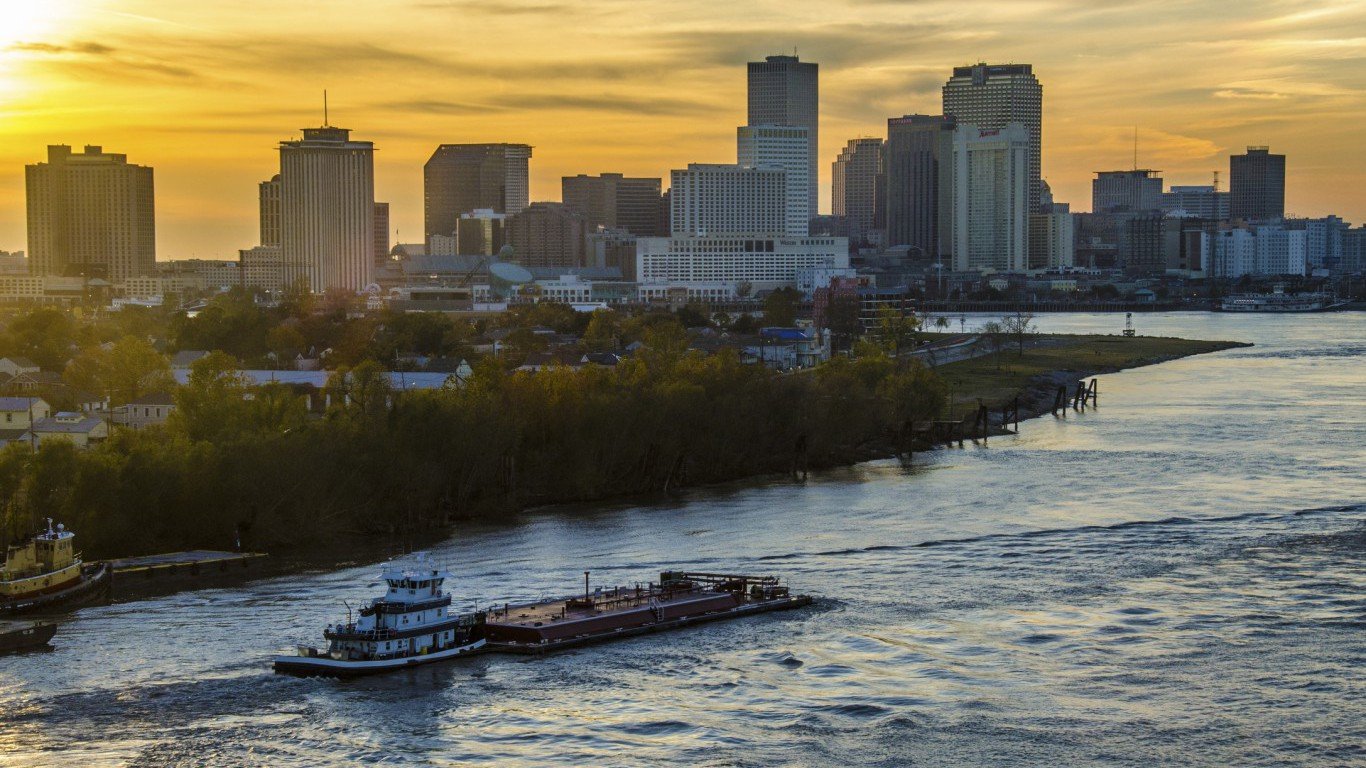
15. Louisiana
> Underemployment rate: 10.6%
> June unemployment rate: 6.2% (3rd highest)
> Median wage: $31,980 (11th lowest)
> Labor force growth: 0.0% (6th smallest growth)
During the recession, Louisiana’s economy fared better than most states, in part because of financial assistance for Hurricane Katrina and a booming oil sector aided by high gas prices. With lower gas prices in recent years, however, the state’s economy has not done as well. The unemployment rate remained at a relatively high 6.2% between June 2015 and June 2016, and total employment declined over the same period. The largest loss occurred in the mining and logging industry, which shrank by 8,300 workers. Of all willing and able workers in the state, 10.6% are underemployed, one of the higher rates nationwide.

14. South Carolina
> Underemployment rate: 10.6%
> June unemployment rate: 5.4% (15th highest)
> Median wage: $31,280 (5th lowest)
> Labor force growth: 2.7% (6th largest growth)
Over the last year, the South Carolina labor force grew by 2.7%, the sixth fastest growth rate in the country. The state economy can seemingly accommodate the new workers, as the unemployment rate fell from 5.9% to 5.4% over the same period. The professional and business services sector added the most new workers, growing by 14,300 new employees.
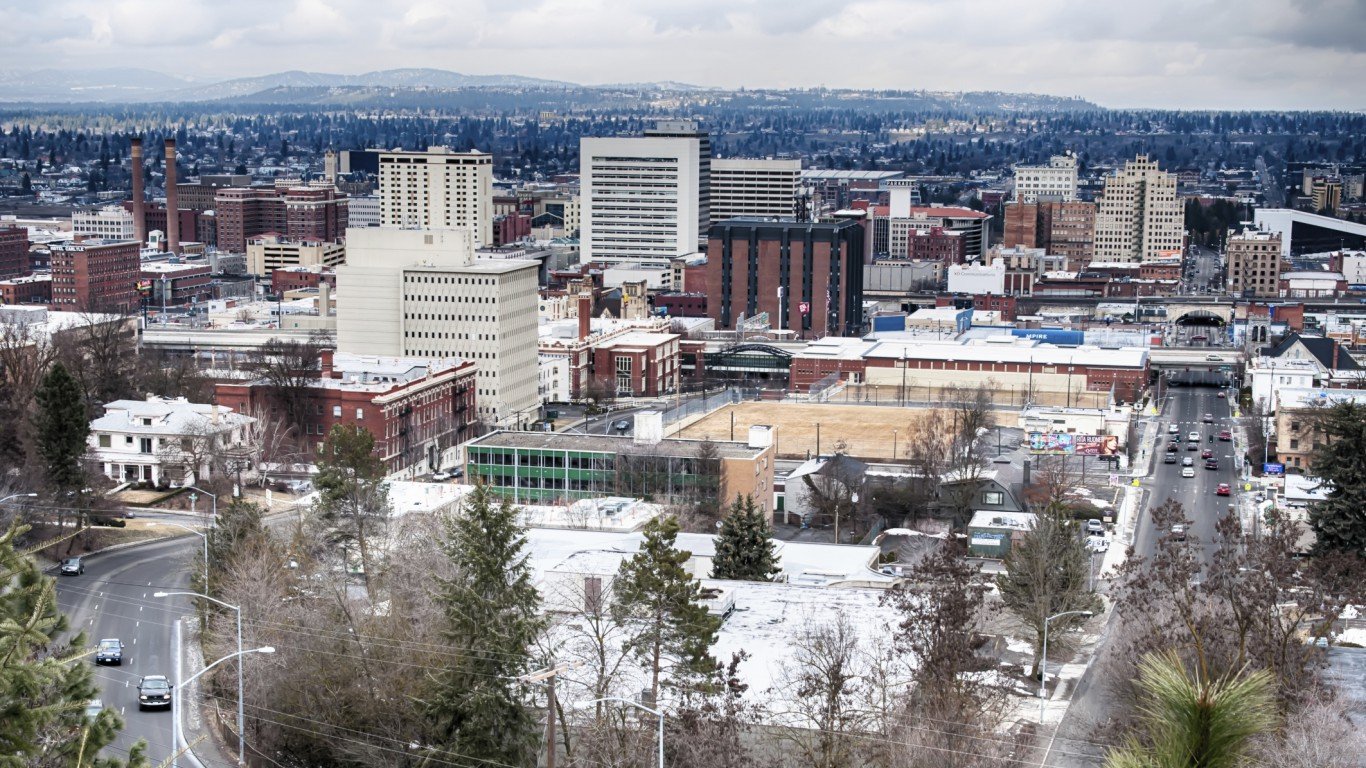
13. Washington
> Underemployment rate: 10.7%
> June unemployment rate: 5.8% (9th highest)
> Median wage: $42,190 (4th highest)
> Labor force growth: 2.6% (8th largest growth)
Nationwide, unemployment declined by 0.4 percentage points between 2015 and 2016. In Washington, however, unemployment actually increased by two tenths of a percentage point. Increasing unemployment in the state is partially due to a relatively rapid labor force growth rate. Nearly 100,000 people entered the state’s work force in the past year, a 2.6% overall increase, more than in all but a handful of other states.

12. Michigan
> Underemployment rate: 10.8%
> June unemployment rate: 4.6% (24th lowest)
> Median wage: $35,400 (22nd highest)
> Labor force growth: 2.2% (12th largest growth)
At one time during the recession, Michigan had the highest unemployment rate in the country. Since the peak of the crisis, the state’s unemployment rate has fallen by 7.2 percentage points — more than any other state. Today the state has a below average unemployment rate, rather than the highest. However, as is the case in a number of states, a post-recession improvement in the overall unemployment rate may paint a misleadingly positive picture of the state’s economic recovery. As the unemployment rate went down, Michigan’s underemployment rate — 10.8% — remained above average, as workers gave up looking for full-time work. An estimated 4.6% of the state’s workers are employed part-time because they cannot find full-time jobs, the fourth highest share in the country.
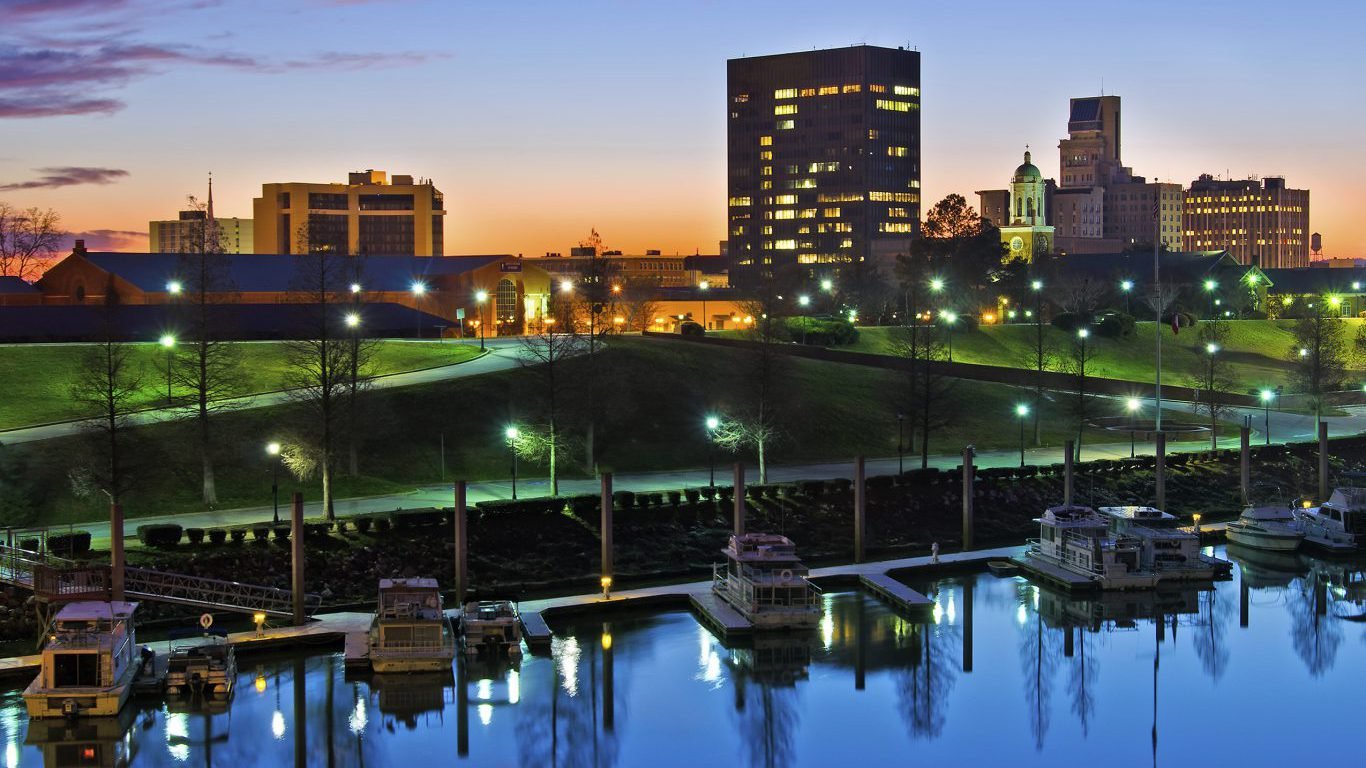
11. Georgia
> Underemployment rate: 10.9%
> June unemployment rate: 5.1% (17th highest)
> Median wage: $33,430 (18th lowest)
> Labor force growth: 2.5% (9th largest growth)
A larger share of Georgians are either unemployed, underemployed, or too discouraged to look for work than is typical across the country. For those able to secure a job in the state, median wages are slightly below what the typical American earns. Still, the state’s economy is showing signs of improvement. In the last year, the state unemployment rate declined by 0.7 percentage points, even as the size of the workforce increased by 2.5%.
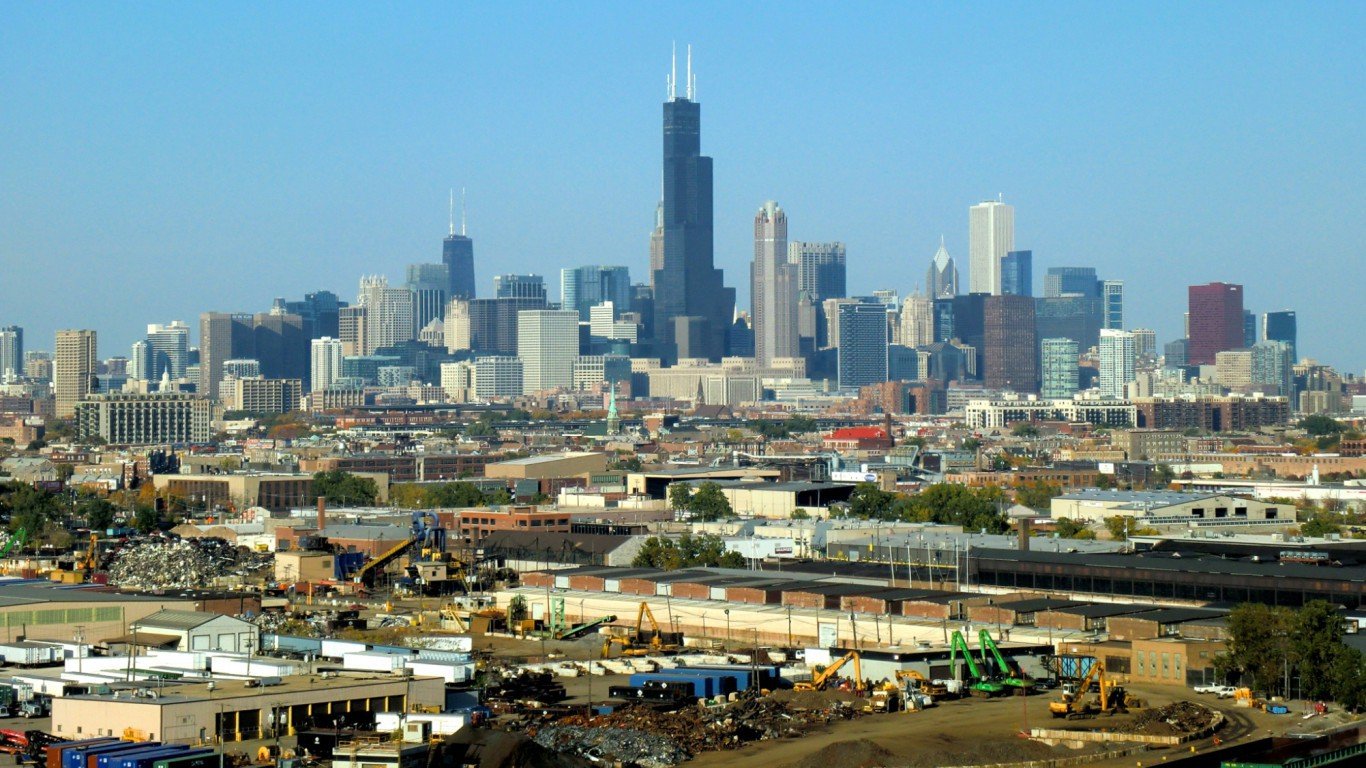
10. Illinois
> Underemployment rate: 11.0%
> June unemployment rate: 6.2% (3rd highest)
> Median wage: $37,320 (17th highest)
> Labor force growth: 1.9% (16th largest growth)
Over the last year, the Illinois labor force grew by 1.9%, slightly faster than the national growth rate. The state’s economy may not have been able to accommodate the new workers, however, as over the same period the unemployment grew from 5.8% to 6.2% — the third highest of any state today. The rising unemployment may be one reason behind the high labor underutilization in the state. Of all willing and able workers in Illinois, 11.0% are either unemployed, working in part-time job over a full-time job for economic reasons, or are discouraged from seeking work altogether, higher than the 9.9% national underemployment rate.

9. Connecticut
> Underemployment rate: 11.1%
> June unemployment rate: 5.8% (9th highest)
> Median wage: $43,830 (3rd highest)
> Labor force growth: 0.6% (14th smallest growth)
While the unemployment rate has declined nationwide, in Connecticut, the share of the labor force out of work and looking for a job has actually risen. The state’s unemployment rate rose by 0.3 percentage points to 5.8% between 2015 and 2016. By contrast, unemployment nationwide decreased by 0.4 percentage points to 4.9% over the same time period. In addition to high unemployment, Connecticut is also home to a relatively high share of people forced to accept part time work in lieu of full-time employment. Of the people in Connecticut’s labor force, in addition to those who have dropped out of the labor market, 4.1% are part-timers who would prefer full-time work, tied for the 10th highest such percentage of all states.
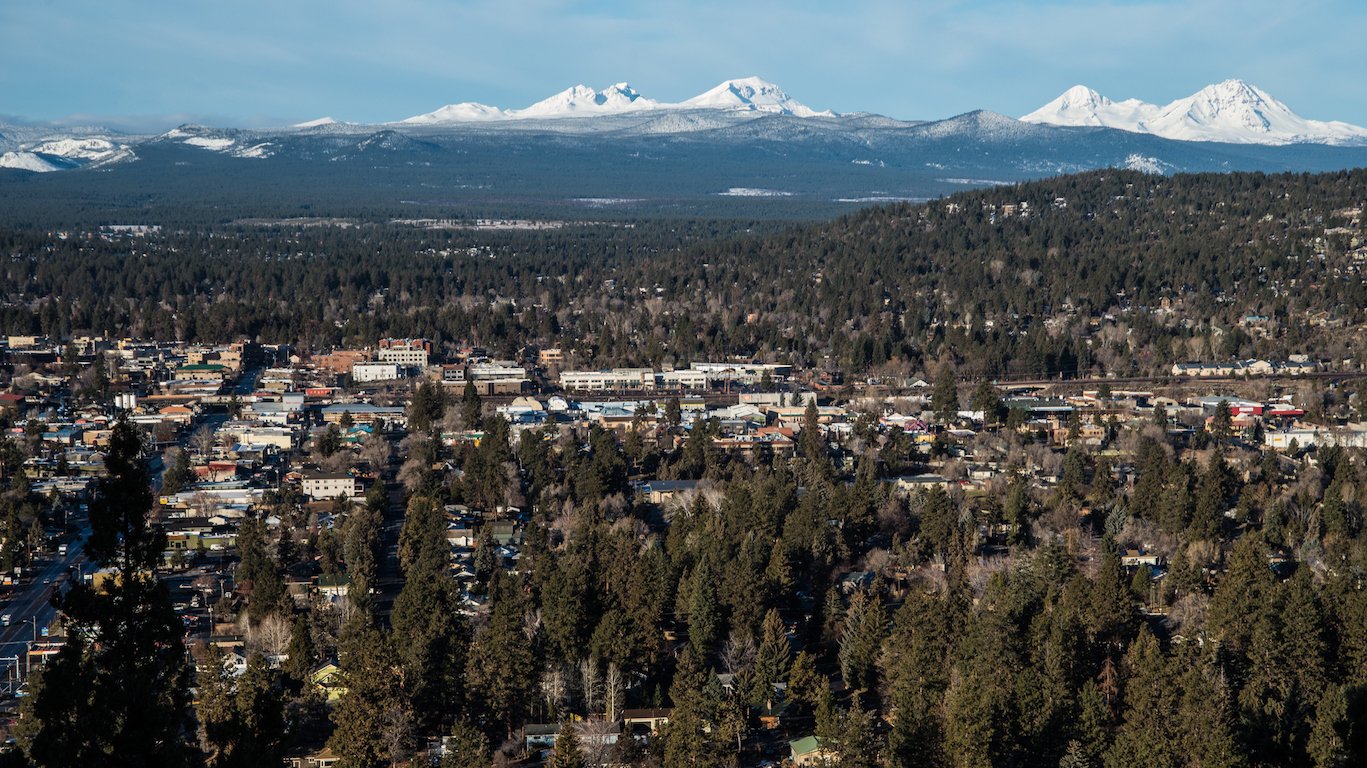
8. Oregon
> Underemployment rate: 11.1%
> June unemployment rate: 4.8% (22nd highest)
> Median wage: $37,080 (19th highest)
> Labor force growth: 4.6% (the largest growth)
In 2009, when national unemployment was at its peak, Oregon had the sixth-highest unemployment rate in the country. Since 2009, however, unemployment in the state has declined by 5.6 percentage points, a greater improvement than every state but Michigan. The state’s current unemployment rate of 4.8% falls in line with the national rate of 4.9%.
However, the improvement in the state’s traditional unemployment rate may create a misleading image of the state’s economy. For example, while a number of Oregonians found employment during the recovery, it appears that many were forced into part-time work because nothing else was available. Nearly 5% of the state’s residents who are willing and able to work are involuntary part-time workers, more than all but two states.

7. Mississippi
> Underemployment rate: 11.2%
> June unemployment rate: 5.9% (8th highest)
> Median wage: $29,000 (the lowest)
> Labor force growth: 0.8% (21st smallest growth)
In Mississippi, 11.2% of all willing and able workers in the state are either unemployed, discouraged from seeking work, or involuntarily working at part-time rather than full-time jobs. According to the BLS, one of the primary reasons for discouragement is a lack of schooling or training. Just 82.8% of Mississippi adults have at least a high school diploma, the third smallest percentage of any state.
The retail industry is one of the most likely industries to offer only part-time work. A relatively high 12.4% of all Mississippi workers are in the retail industry, which may be one reason for the large share of involuntary part-time workers in the state . Retail also tends to pay less than other industries, which may depress wages in the state. The typical Mississippi employee earns $29,000 annually, the lowest median wage nationwide.
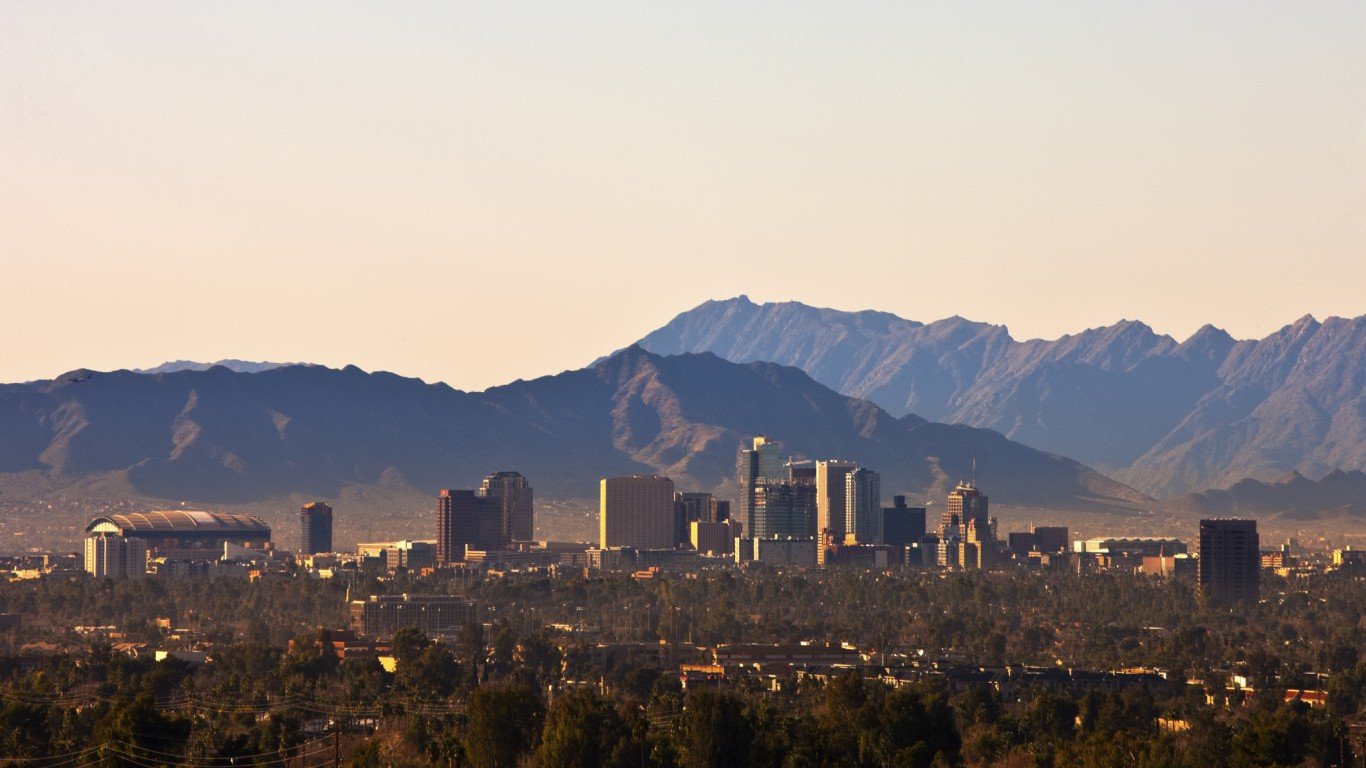
6. Arizona
> Underemployment rate: 11.3%
> June unemployment rate: 5.8% (9th highest)
> Median wage: $34,680 (25th lowest)
> Labor force growth: 3.2% (4th largest growth)
Arizona is among the 10 most difficult states to find full-time work. Compared with this time last year, however, job seekers are much better off. The state’s underemployment rate fell 2.5 percentage points from 13.8%, nearly the largest improvement of any state. Over the 12 months through June, the state’s labor force also grew by 3.2%, the fourth largest such growth and another positive sign for the labor market.
Arizona was one of the states hit hardest by the housing crisis, however, and has not fully recovered. Arizona still has nearly the highest share of homes with underwater mortgages, at 15.4%, according to CoreLogic. It is far more difficult for distressed homeowners, who may also be out of work or underemployed, to relocate.
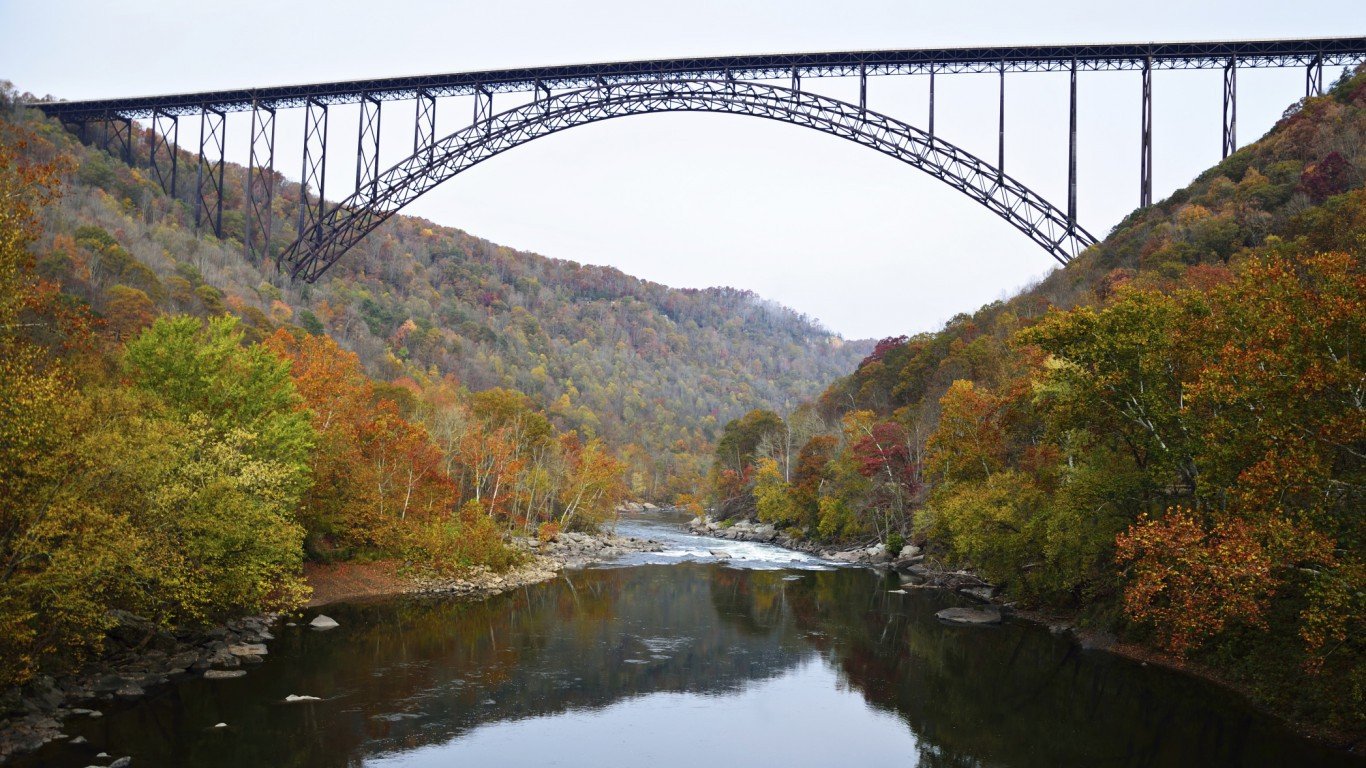
5. West Virginia
> Underemployment rate: 11.4%
> June unemployment rate: 6.0% (6th highest)
> Median wage: $30,240 (3rd lowest)
> Labor force growth: -0.5% (3rd largest decline)
Only 52.7% of West Virginia’s population participates in the labor force, the smallest share of any state in the country. High numbers of recent retirees can drive down labor force participation. In the case of West Virginia, however, discouraged workers dropping out of the labor force is a more likely factor. The state has one of the nation’s highest levels of jobless workers who have given up their search for employment.
The state’s relatively weak job market may be attributable to an over-reliance on the mining industry, which has been struggling across the nation. In West Virginia, 5.2% of the workforce is employed in the agriculture, forestry, and mining industry, more than double the corresponding national share. In the last year alone, that industry shed roughly 5,100 jobs in West Virginia, the largest employment decrease of any industry in the state.
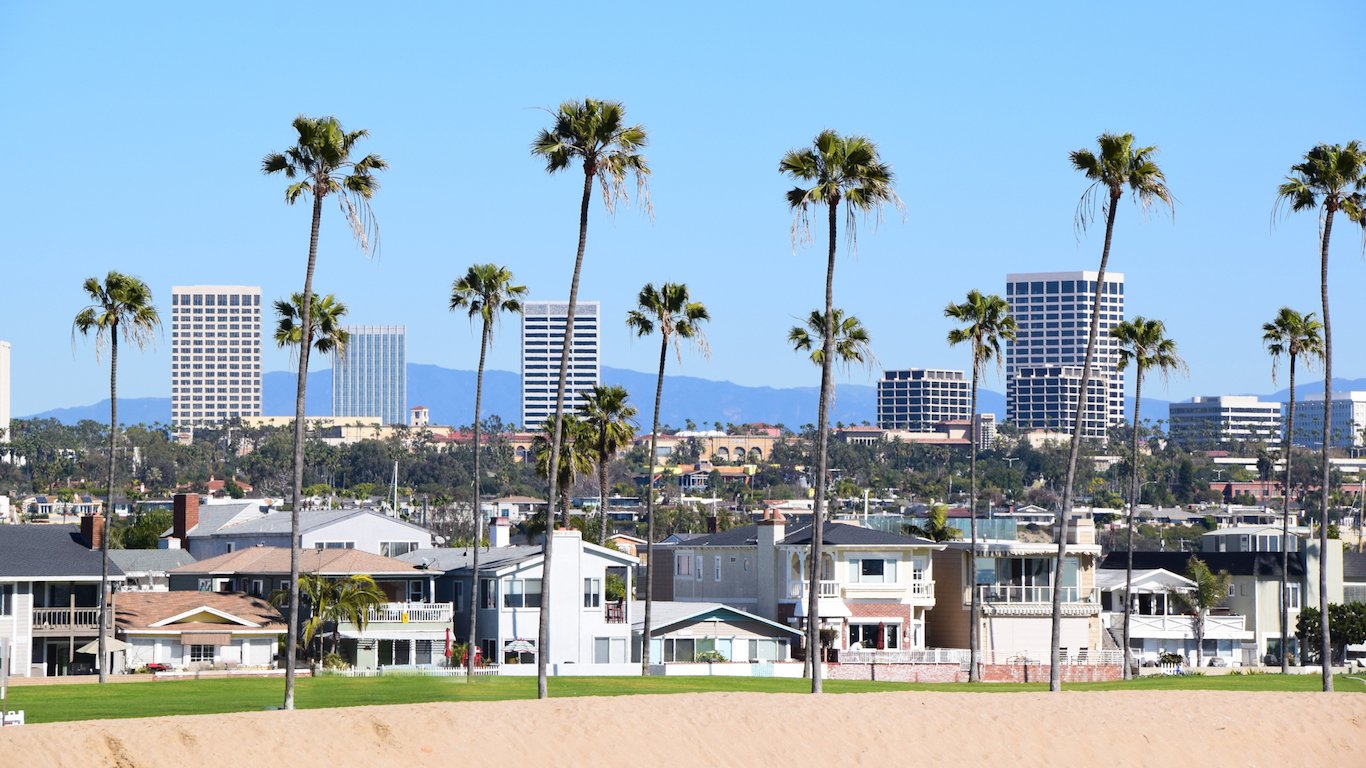
4. California
> Underemployment rate: 11.7%
> June unemployment rate: 5.4% (15th highest)
> Median wage: $39,830 (8th highest)
> Labor force growth: 0.8% (19th smallest growth)
At just over 19 million people, California’s labor force is by far the largest in the country. Many of those workers, however, are underserved by the job market. The state’s 5.4% unemployment rate is above the 4.9% national rate. Furthermore, a near nation-leading 4.9% of the state’s willing and able workers are forced to take part-time rather than full-time work.
Many in the state who are unable to find work may be underprepared for the job market. Only 82.1% of adults have graduated high school, the lowest high school attainment rate of any state in the country.

3. Alaska
> Underemployment rate: 11.9%
> June unemployment rate: 6.7% (the highest)
> Median wage: $46,420 (the highest)
> Labor force growth: -1.2% (2nd largest decline)
Workers in Alaska earn some of the highest wages in the country. The typical wage of $46,420 is the highest of all states and considerably higher than the national average of $36,200. The state’s job market is not doing especially well, however. The unemployment rate in June was 6.7%, the highest in the country. Unlike other high underemployment states, however, the share of workers employed part-time for economic reasons is below-average. This is likely due to the state’s high reliance on the mining sector, which does not tend to offer as many part-time positions as other industries. While involuntary part-timers are not as common in the state, discouraged job-seekers are, which largely accounts for the state’s near nation-leading underemployment rate. Like a number of other states with high levels of discouraged workers and underemployment, Alaska’s mining, logging and construction industries lost more jobs than any other sector in the state.
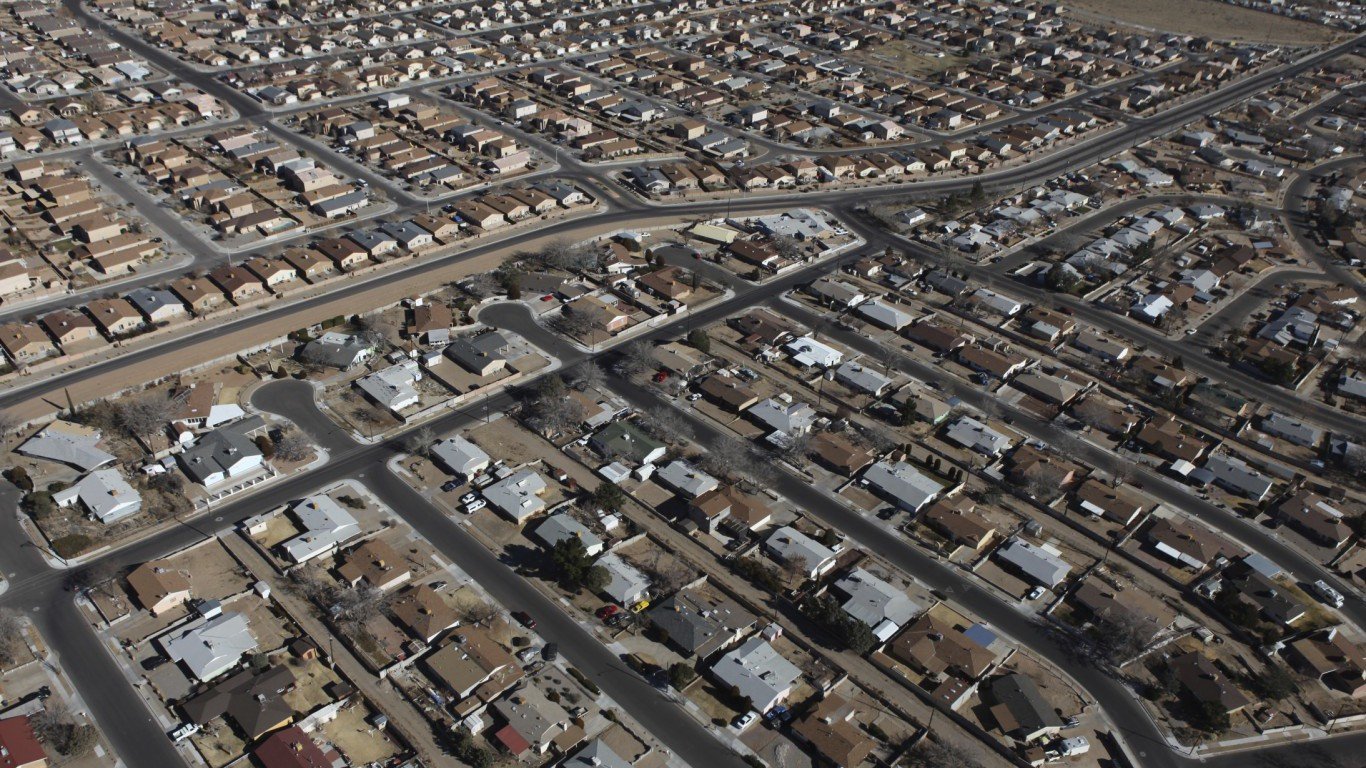
2. New Mexico
> Underemployment rate: 12.4%
> June unemployment rate: 6.2% (3rd highest)
> Median wage: $32,320 (12th lowest)
> Labor force growth: 0.6% (13th smallest growth)
Just 57.4% of New Mexico residents are in the labor force, the fifth lowest participation rate in the country. The state’s economy shows other signs of poor health and labor underutilization. Despite dropping over the the past year, New Mexico’s 6.2% unemployment rate is the third highest in the country. In addition, 4.5% of workers have involuntary part-time rather than full-time jobs and 0.6% are discouraged from seeking a job altogether, making New Mexico one of the hardest places to find full-time work nationwide.
Workers in the arts, entertainment, accommodation, and food services sector are less likely to find full-time work than those in other industries. A relatively large 11.6% of all New Mexico workers are employed in the arts, entertainment, accommodation, and food services sector, which may be one reason for the large share of involuntary part-time workers in the state.
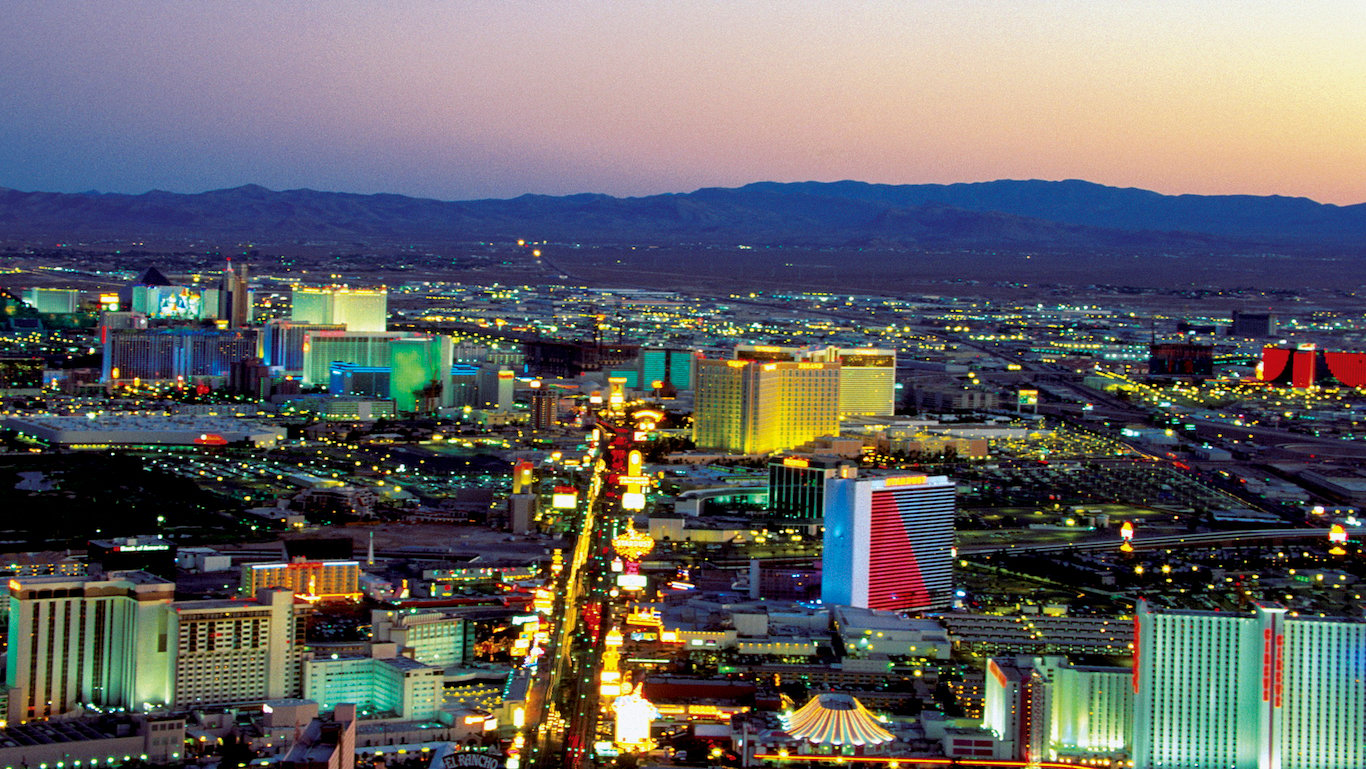
1. Nevada
> Underemployment rate: 13.1%
> June unemployment rate: 6.4% (2nd highest)
> Median wage: $33,700 (21st lowest)
> Labor force growth: 0.9% (22nd smallest growth)
Nevada is the worst state for people seeking full-time, gainful employment. The state was among the hardest hit by the housing crisis, and the slow recovery partially accounts for the struggling job market. The dominance of hospitality and service-related jobs also helps explain the high level of underemployment in the state. More than 26% of Nevadan workers are employed in the arts, entertainment, accommodation and food services sector, the highest percentage of any state. For workers in these industries, part-time employment is much more common. The share of all workers, as well as involuntary part-time employees, is highest in Nevada.
A financial advisor can help you understand the advantages and disadvantages of investment properties. Finding a qualified financial advisor doesn’t have to be hard. SmartAsset’s free tool matches you with up to three financial advisors who serve your area, and you can interview your advisor matches at no cost to decide which one is right for you. If you’re ready to find an advisor who can help you achieve your financial goals, get started now.
Investing in real estate can diversify your portfolio. But expanding your horizons may add additional costs. If you’re an investor looking to minimize expenses, consider checking out online brokerages. They often offer low investment fees, helping you maximize your profit.
Thank you for reading! Have some feedback for us?
Contact the 24/7 Wall St. editorial team.